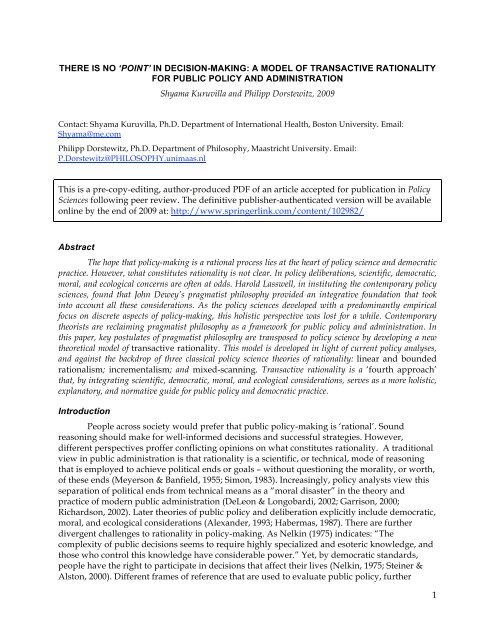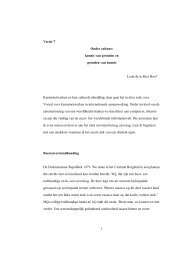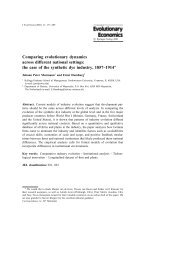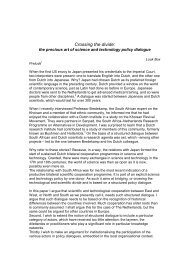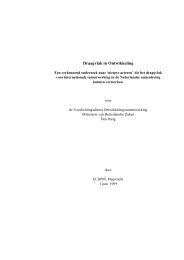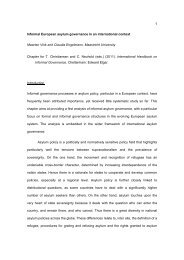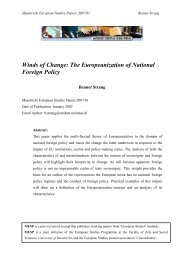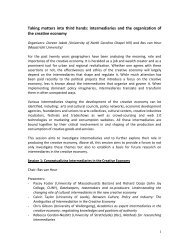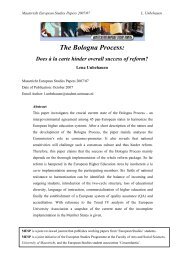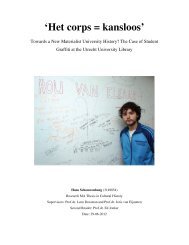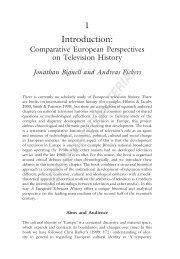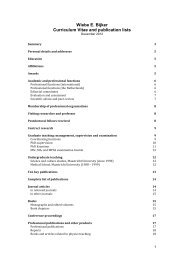'point' in decision-making - Maastricht University
'point' in decision-making - Maastricht University
'point' in decision-making - Maastricht University
You also want an ePaper? Increase the reach of your titles
YUMPU automatically turns print PDFs into web optimized ePapers that Google loves.
THERE IS NO ‘POINT’ IN DECISION-MAKING: A MODEL OF TRANSACTIVE RATIONALITY<br />
FOR PUBLIC POLICY AND ADMINISTRATION<br />
Shyama Kuruvilla and Philipp Dorstewitz, 2009<br />
Contact: Shyama Kuruvilla, Ph.D. Department of International Health, Boston <strong>University</strong>. Email:<br />
Shyama@me.com<br />
Philipp Dorstewitz, Ph.D. Department of Philosophy, <strong>Maastricht</strong> <strong>University</strong>. Email:<br />
P.Dorstewitz@PHILOSOPHY.unimaas.nl<br />
This is a pre-copy-edit<strong>in</strong>g, author-produced PDF of an article accepted for publication <strong>in</strong> Policy<br />
Sciences follow<strong>in</strong>g peer review. The def<strong>in</strong>itive publisher-authenticated version will be available<br />
onl<strong>in</strong>e by the end of 2009 at: http://www.spr<strong>in</strong>gerl<strong>in</strong>k.com/content/102982/<br />
Abstract<br />
The hope that policy-mak<strong>in</strong>g is a rational process lies at the heart of policy science and democratic<br />
practice. However, what constitutes rationality is not clear. In policy deliberations, scientific, democratic,<br />
moral, and ecological concerns are often at odds. Harold Lasswell, <strong>in</strong> <strong>in</strong>stitut<strong>in</strong>g the contemporary policy<br />
sciences, found that John Dewey’s pragmatist philosophy provided an <strong>in</strong>tegrative foundation that took<br />
<strong>in</strong>to account all these considerations. As the policy sciences developed with a predom<strong>in</strong>antly empirical<br />
focus on discrete aspects of policy-mak<strong>in</strong>g, this holistic perspective was lost for a while. Contemporary<br />
theorists are reclaim<strong>in</strong>g pragmatist philosophy as a framework for public policy and adm<strong>in</strong>istration. In<br />
this paper, key postulates of pragmatist philosophy are transposed to policy science by develop<strong>in</strong>g a new<br />
theoretical model of transactive rationality. This model is developed <strong>in</strong> light of current policy analyses,<br />
and aga<strong>in</strong>st the backdrop of three classical policy science theories of rationality: l<strong>in</strong>ear and bounded<br />
rationalism; <strong>in</strong>crementalism; and mixed-scann<strong>in</strong>g. Transactive rationality is a ‘fourth approach’<br />
that, by <strong>in</strong>tegrat<strong>in</strong>g scientific, democratic, moral, and ecological considerations, serves as a more holistic,<br />
explanatory, and normative guide for public policy and democratic practice.<br />
Introduction<br />
People across society would prefer that public policy-mak<strong>in</strong>g is ‘rational’. Sound<br />
reason<strong>in</strong>g should make for well-<strong>in</strong>formed <strong>decision</strong>s and successful strategies. However,<br />
different perspectives proffer conflict<strong>in</strong>g op<strong>in</strong>ions on what constitutes rationality. A traditional<br />
view <strong>in</strong> public adm<strong>in</strong>istration is that rationality is a scientific, or technical, mode of reason<strong>in</strong>g<br />
that is employed to achieve political ends or goals – without question<strong>in</strong>g the morality, or worth,<br />
of these ends (Meyerson & Banfield, 1955; Simon, 1983). Increas<strong>in</strong>gly, policy analysts view this<br />
separation of political ends from technical means as a “moral disaster” <strong>in</strong> the theory and<br />
practice of modern public adm<strong>in</strong>istration (DeLeon & Longobardi, 2002; Garrison, 2000;<br />
Richardson, 2002). Later theories of public policy and deliberation explicitly <strong>in</strong>clude democratic,<br />
moral, and ecological considerations (Alexander, 1993; Habermas, 1987). There are further<br />
divergent challenges to rationality <strong>in</strong> policy-mak<strong>in</strong>g. As Nelk<strong>in</strong> (1975) <strong>in</strong>dicates: “The<br />
complexity of public <strong>decision</strong>s seems to require highly specialized and esoteric knowledge, and<br />
those who control this knowledge have considerable power.” Yet, by democratic standards,<br />
people have the right to participate <strong>in</strong> <strong>decision</strong>s that affect their lives (Nelk<strong>in</strong>, 1975; Ste<strong>in</strong>er &<br />
Alston, 2000). Different frames of reference that are used to evaluate public policy, further<br />
1
exacerbate the tension between demands for expert knowledge and public participation.<br />
Scientific, ideological, economic, political, procedural, cultural, or ecological frames often<br />
produce <strong>in</strong>compatible recommendations (Durie, 2004; Roth, Dunsby, & Bero, 2003). For<br />
example, Roth et al. (2003) analysed public commentary on proposed Food and Drug<br />
Adm<strong>in</strong>istration regulations <strong>in</strong> the U.S. and concluded that:<br />
Though scientists and regulatory experts may identify and present scientific evidence to <strong>in</strong>dicate<br />
proposed regulations’ technical rationality, the social problems that these regulations address may<br />
always be reframed <strong>in</strong> moral terms that underm<strong>in</strong>e the regulation’s legitimacy (Roth, et al., 2003,<br />
p. 36).<br />
In policy science, public adm<strong>in</strong>istration, and plann<strong>in</strong>g, the classic models of rationality<br />
are: l<strong>in</strong>ear rationalism (Meyerson & Banfield, 1955); bounded rationality (Simon, 1957);<br />
<strong>in</strong>crementalism (L<strong>in</strong>dblom, 1959); and mixed scann<strong>in</strong>g (Etzioni, 1967). These models describe<br />
policy processes and offer alternative perspectives on how these processes may be rationally<br />
organised. Other policy theories describe diverse aspects of policy-mak<strong>in</strong>g based on empirical<br />
analyses, for example, of: agenda sett<strong>in</strong>g; policy networks and advocacy coalitions; policy<br />
formulation; and implementation (John, 1998; K<strong>in</strong>gdon, 1995; Parsons, 1995; Sabatier, 1999).<br />
This plethora of theoretical and empirical perspectives is not sufficiently <strong>in</strong>tegrated to provide<br />
an explanatory overview of policy-mak<strong>in</strong>g, or to serve as a normative guide for rational public<br />
policy. Policy theorists recognize the need for more holistic, explanatory, and normative policy<br />
theory (deHaven-Smith, 1988; DeLeon & Longobardi, 2002; John, 1998; Parsons, 1995; Sabatier,<br />
1999). One of the ma<strong>in</strong> challenges to achiev<strong>in</strong>g this goal, as deHaven Smith (1988) asserts <strong>in</strong><br />
Philosophical Critiques of Policy Analysis, is that:<br />
The facts confront us like pebbles <strong>in</strong> a kaleidoscope, capable of be<strong>in</strong>g rearranged and re<strong>in</strong>terpreted<br />
with a twist of the theoretical lens. It is time to discard this fruitless approach to policy analysis<br />
and to explore alternatives grounded <strong>in</strong> comprehensive social and political theory (deHaven-<br />
Smith, 1988, p. 126).<br />
This paper posits that classical pragmatist philosophy provides a comprehensive<br />
epistemology for the policy sciences. This idea is not new and is, <strong>in</strong> fact, the foundation on<br />
which the contemporary policy sciences were built. As Harold Lasswell acknowledged:<br />
The policy sciences are a contemporary policy adaptation of the general approach to public policy<br />
that was recommended by John Dewey and his colleagues <strong>in</strong> the development of American<br />
pragmatism (Lasswell, 1971, p. xiv).<br />
Dewey developed a holistic philosophy that sought to improve rationality <strong>in</strong> human agency by<br />
<strong>in</strong>tegrat<strong>in</strong>g the scientific, democratic, moral, and ecological dimensions of reason<strong>in</strong>g. This<br />
holistic perspective was lost as policy science developed with a more narrow technical and<br />
empirical focus. There is now grow<strong>in</strong>g <strong>in</strong>terest <strong>in</strong> reclaim<strong>in</strong>g Deweyan pragmatist philosophy<br />
as a comprehensive bluepr<strong>in</strong>t for public policy and democratic practice (Bernste<strong>in</strong>, 1998;<br />
Dorstewitz & Kuruvilla, 2007; Evans, 2000; Joas, 1996; Mousavi & Garrison, 2003; Ryan, 2000;<br />
Shields, 2003; Shook, 2003; Snider, 2000; Westbrook, 1991). The objective of this paper is to<br />
transpose rationality as envisioned <strong>in</strong> pragmatist philosophy to policy science. To do this, a new<br />
model of rational public policy is developed.<br />
The task of apply<strong>in</strong>g classical Deweyan pragmatism to contemporary policy science is<br />
not without its challenges. Consider Dewey’s def<strong>in</strong>ition of rationality:<br />
2
Rationality is not a force to evoke aga<strong>in</strong>st impulse and habit. It is the atta<strong>in</strong>ment of a work<strong>in</strong>g<br />
harmony among diverse desires. “Reason” as a noun signifies the happy cooperation of a<br />
multitude of dispositions, such as sympathy, curiosity, exploration, experimentation, frankness,<br />
pursuit — to follow th<strong>in</strong>gs through — circumspection, to look about at the context, etc., etc. The<br />
elaborate systems of science are born not of reason but of impulses at first slight and flicker<strong>in</strong>g;<br />
impulses to handle, move about, to hunt, to uncover, to mix th<strong>in</strong>gs separated and divide th<strong>in</strong>gs<br />
comb<strong>in</strong>ed, to talk and to listen. Method is their effectual organization <strong>in</strong>to cont<strong>in</strong>uous<br />
dispositions of <strong>in</strong>quiry, development and test<strong>in</strong>g. It occurs after these acts and because of their<br />
consequences. Reason, the rational attitude, is the result<strong>in</strong>g disposition, not a ready-made<br />
antecedent which can be <strong>in</strong>voked at will and set <strong>in</strong>to movement (Dewey, 1922/ 2002, p. 196).<br />
Not only is this a complex, possibly abstruse, explanation, it also draws on the depth and<br />
breadth of Dewey’s comprehensive and <strong>in</strong>tegrative work. 1 Pragmatist scholars caution aga<strong>in</strong>st a<br />
piecemeal read<strong>in</strong>g of pragmatist philosophy and recommend that Dewey’s work be<br />
synthesized, and systematized, before application (Caspary, 2000; Garrison, 2000; Hickman,<br />
2004; Ryan, 1995; Schilpp & Hahn, 1939/ 1989; Snider, 2000). Four foundational constructs <strong>in</strong><br />
pragmatist philosophy are used to build the new model of rationality <strong>in</strong> this paper. These<br />
constructs are presented here as ‘postulates’ 2:<br />
I. The start<strong>in</strong>g po<strong>in</strong>t of rationality is not a predef<strong>in</strong>ed problem or goal, but an <strong>in</strong>determ<strong>in</strong>ate<br />
situation;<br />
II. Rationality is a product of <strong>in</strong>quiry <strong>in</strong> democratic communities;<br />
III. Rationality <strong>in</strong>tegrates scientific, moral, and ecological reason<strong>in</strong>g; and<br />
IV. Rationality is only successful if it serves as a guide towards satisfactory consequences <strong>in</strong><br />
both theory and practice.<br />
These postulates are transposed to a new model of rational public policy, the transactive<br />
rationality model, which is presented as a ‘fourth approach’ to l<strong>in</strong>ear rationalism, <strong>in</strong>crementalism,<br />
and mixed-scann<strong>in</strong>g. By <strong>in</strong>tegrat<strong>in</strong>g scientific, democratic, moral, and ecological considerations,<br />
pragmatist rationality serves as a more holistic, explanatory, and normative guide for public<br />
policy and democratic practice.<br />
Postulate I. The start<strong>in</strong>g po<strong>in</strong>t of rationality is not a predef<strong>in</strong>ed problem or goal, but an<br />
<strong>in</strong>determ<strong>in</strong>ate situation<br />
L<strong>in</strong>ear rationality is a primary reference for most other models of rationality, which are<br />
either modifications of this model or explicit rejections of it (Dorstewitz & Kuruvilla, 2007;<br />
Schoenwandt, 2008). The start<strong>in</strong>g po<strong>in</strong>t for agency <strong>in</strong> l<strong>in</strong>ear rational models (Figure 1), based on<br />
Humean psychology, is a pre-def<strong>in</strong>ed, given set of ‘ends’ (e.g. ‘passions’, preferences, problems,<br />
or goals). These ends are matched with available ‘means’ (e.g. beliefs, resources, and guides -<br />
such as practice standards), which are then implemented to address or achieve the ends.<br />
1 Dewey wrote over 400 journal articles and 40 books. He also gave a series of public speeches and<br />
lectures, and wrote essays, policy briefs, letters and articles <strong>in</strong> popular magaz<strong>in</strong>es and newspapers,<br />
<strong>in</strong>clud<strong>in</strong>g <strong>in</strong> the New Republic and New York Times.<br />
2 The term postulate is used here to reflect the fact that much of Dewey’s philosophy is constructed as<br />
<strong>in</strong>ference or argument that he fully <strong>in</strong>tended should be tested and further developed through <strong>in</strong>quiry and<br />
application. For example, <strong>in</strong> his theory of ethics Dewey explicitly refers to “The Ethical Postulate”.<br />
3
Figure 1: The l<strong>in</strong>ear rational model<br />
In policy theory, l<strong>in</strong>ear rationality is reflected <strong>in</strong> the seem<strong>in</strong>gly ubiquitous ‘stages’ model<br />
(Parsons, 1995; Sabatier, 1999). The stages model depicts policy-mak<strong>in</strong>g as mov<strong>in</strong>g through<br />
dist<strong>in</strong>ct steps of policy agenda sett<strong>in</strong>g, formulation, <strong>decision</strong>-mak<strong>in</strong>g, implementation, and evaluation.<br />
In policy practice, l<strong>in</strong>ear rational th<strong>in</strong>k<strong>in</strong>g is evident when public preferences and political<br />
positions are <strong>in</strong>voked as <strong>in</strong>violate guides for future policy projects. The classic rationality<br />
models also explicitly, or implicitly, assume that policy problems and purposes ‘exist’ outside<br />
<strong>in</strong>quiry and deliberation processes. Bounded rationality recognizes that there are contextual<br />
constra<strong>in</strong>ts to coord<strong>in</strong>at<strong>in</strong>g knowledge and action <strong>in</strong> order to maximize given ends. Rationality<br />
is then not the development of ultimate or optimal strategies, but a ‘satisfic<strong>in</strong>g’ or ‘bounded’<br />
search for solutions given these constra<strong>in</strong>ts (Simon, 1957). Incrementalism rejects the idea of<br />
centrally conceived plann<strong>in</strong>g, and <strong>in</strong>stead describes a cont<strong>in</strong>uum of decentralized, <strong>in</strong>cremental<br />
changes that demand frequent review, but that are oriented to some overarch<strong>in</strong>g goal<br />
(L<strong>in</strong>dblom, 1959). Etzioni (1967) proposed ‘mixed scann<strong>in</strong>g’ as a “third approach” to Simon’s<br />
bounded rationality and L<strong>in</strong>dblom’s <strong>in</strong>crementalism. Mixed scann<strong>in</strong>g is a search process that<br />
comb<strong>in</strong>es a wide perspective on potential policy solutions, with an <strong>in</strong>-depth analysis of the most<br />
compell<strong>in</strong>g options, but what constitutes a policy problem seems unproblematic.<br />
The l<strong>in</strong>ear rational model is untenable on empirical, theoretical, and moral grounds. In<br />
practice, public policy problems and goals are rarely well def<strong>in</strong>ed at the outset. Analysts<br />
describe <strong>in</strong>sufficiently understood, <strong>in</strong>determ<strong>in</strong>ate, and “messy” problematic situations as the<br />
start<strong>in</strong>g po<strong>in</strong>t of most public plann<strong>in</strong>g and policy projects (Checkland, 1999; Rosenhead &<br />
M<strong>in</strong>gers, 2001; Shields, 2003). To counteract the l<strong>in</strong>ear stages theory of policy-mak<strong>in</strong>g,<br />
contemporary theorists provide a vivid assortment of alternative images. These <strong>in</strong>clude: ‘the<br />
layered formation of a pearl’ (Weiss, 1980); ‘cubist pa<strong>in</strong>t<strong>in</strong>gs’ and ‘mosaics’ (Shields, 1996);<br />
‘garbage cans’ (Cohen, March, & Olsen, 1972); ‘concurrent streams of policy, politics and<br />
problems’ and ‘w<strong>in</strong>dows of opportunity’ (K<strong>in</strong>gdon, 1995).<br />
From a moral perspective, ends and desires that are not subject to <strong>in</strong>quiry and<br />
deliberation can be perverse. To illustrate this po<strong>in</strong>t, Elster (1991) recounts the fable of Aesop’s<br />
fox who, upon unsuccessfully try<strong>in</strong>g to reach a desired bunch of grapes, mitigated his<br />
disappo<strong>in</strong>tment by decid<strong>in</strong>g that the “grapes were sour”. Conversely the "grass is greener on the<br />
other side of the fence" syndrome is associated with desires that are permanently beyond reach<br />
(Elster, 1991). Ends that rema<strong>in</strong> unexam<strong>in</strong>ed, because they are considered as ‘given’, can lead to<br />
illogical conclusions and undesirable consequences. If ‘given’ or unexam<strong>in</strong>ed ends can be<br />
perverse, then f<strong>in</strong>d<strong>in</strong>g ways to gratify them, may neither be <strong>in</strong> anyone’s <strong>in</strong>terest, nor a moral<br />
exercise accord<strong>in</strong>g to a wider view of rationality (Richardson, 2002).<br />
Indeterm<strong>in</strong>ate situations as ‘practical start<strong>in</strong>g po<strong>in</strong>ts’ <strong>in</strong> pragmatist philosophy<br />
A century earlier, John Dewey reflected on the <strong>in</strong>determ<strong>in</strong>ate nature of problematic<br />
situations (Dewey, 1910/ 1997, 1994). He concluded that it was untenable to separate reflection<br />
on strategies and constra<strong>in</strong>ts from reflection on related ends and preferences. In pragmatist<br />
philosophy, an <strong>in</strong>determ<strong>in</strong>ate situation is the “practical start<strong>in</strong>g po<strong>in</strong>t” for rational agency (cf.<br />
Hildebrand, 1999). To establish this alternative start<strong>in</strong>g po<strong>in</strong>t for rational agency (i.e. as opposed<br />
4
to a pre-def<strong>in</strong>ed end or passion), Dewey began by expla<strong>in</strong><strong>in</strong>g how transactions constitute<br />
situations and how situations turn <strong>in</strong>determ<strong>in</strong>ate. “Transaction” is an important, and complex,<br />
concept <strong>in</strong> Dewey’s philosophy, and is foundational to the new transactive rationality model <strong>in</strong><br />
this paper. This model <strong>in</strong>tegrates transactions and relationships that are formative of rational<br />
policy <strong>in</strong>quiry, deliberation, and change.<br />
All liv<strong>in</strong>g be<strong>in</strong>gs are cont<strong>in</strong>ually engaged <strong>in</strong> transactions <strong>in</strong> order to ma<strong>in</strong>ta<strong>in</strong>, or rega<strong>in</strong>,<br />
an organic equilibrium. Transactions, as active life processes, <strong>in</strong>volve both organism and<br />
environment act<strong>in</strong>g together <strong>in</strong> a composite unity. Dewey termed this composite transactive<br />
unity as a “situation”. In any specific functional context, a situation comprises the diversity and<br />
multiple dimensions of related transactions (<strong>in</strong>clud<strong>in</strong>g biological activity, social habits,<br />
<strong>in</strong>dividual thoughts, cultural values, and natural environments) (Dewey, 1910/ 1997, 1994). In<br />
the context of policy-mak<strong>in</strong>g, Hall (1977) describes policy environments as compris<strong>in</strong>g<br />
<strong>in</strong>stitutional, technological, legal, political, economic, demographic, ethical, ideological,<br />
ecological, and cultural dimensions.<br />
Dewey and Bentley (1946) differentiated transaction from self-action (subjects act<strong>in</strong>g<br />
under their own power and volition, as rational choice theories imply) and <strong>in</strong>ter-action (subjects<br />
and objects relat<strong>in</strong>g as separate entities, as the behaviourist stimulus-response, or cause-effect,<br />
model suggests). In transaction, there is no “f<strong>in</strong>al attribution to ‘elements’ or other<br />
presumptively detachable or <strong>in</strong>dependent ‘entities’” (Dewey & Bentley, 1946, p. 509). Classical<br />
pragmatist philosophy def<strong>in</strong>es transaction <strong>in</strong> this specific technical way. However, the quotidian<br />
use of the word conveys a sense that is more like <strong>in</strong>teraction (i.e. buy<strong>in</strong>g and sell<strong>in</strong>g, cause and<br />
effect). To avoid mis<strong>in</strong>terpretation, <strong>in</strong> this paper the word ‘transactive’ is also used <strong>in</strong> place of<br />
‘transaction’, draw<strong>in</strong>g on contemporary pragmatist scholars’ use of this term. For example,<br />
Siegfried (1996 p. 145-146) emphasizes that the “transactive character of experience is its most salient<br />
characteristic for pragmatists. Self and world, thought and action, are reciprocally related.”<br />
Transactions and situations <strong>in</strong> pragmatist philosophy are congruent with ‘systems’<br />
th<strong>in</strong>k<strong>in</strong>g <strong>in</strong> policy-mak<strong>in</strong>g and public adm<strong>in</strong>istration (Ackoff & Emory, 2005; Checkland, 1999;<br />
Vickers, 1965). Though parts and actions <strong>in</strong> a system can be considered <strong>in</strong>dependently, only<br />
together do they constitute a coherent whole. In a systems view entities are not def<strong>in</strong>ed as static<br />
objects, but <strong>in</strong> terms of their dynamic, functional relations. As Sir Geoffery Vickers (1978), a<br />
progenitor of systems th<strong>in</strong>k<strong>in</strong>g <strong>in</strong> public adm<strong>in</strong>istration, expla<strong>in</strong>ed <strong>in</strong> an <strong>in</strong>terview:<br />
Hav<strong>in</strong>g been a lawyer and an adm<strong>in</strong>istrator, I am <strong>in</strong>terested <strong>in</strong> Systems from the personal up to<br />
the very large, human, social systems, I am also <strong>in</strong>terested <strong>in</strong> systems of concepts and values<br />
through which we see all the others which I call appreciative systems.<br />
When situations, or systems, comprise regular, functionally coord<strong>in</strong>ated transactions, a<br />
habitual equilibrium is achieved. When habitual equilibrium is <strong>in</strong>terrupted, an <strong>in</strong>determ<strong>in</strong>ate<br />
situation results. Intentional transactions, or agency, are then orig<strong>in</strong>ated and oriented to def<strong>in</strong>e<br />
the problematic situation, respond, and achieve a new equilibrium (Dewey, 1910/ 1997, 1994). In<br />
policy-mak<strong>in</strong>g, K<strong>in</strong>gdon (1995) describes an ongo<strong>in</strong>g flow of activities <strong>in</strong> politics, problem, and<br />
policy streams. At certa<strong>in</strong> po<strong>in</strong>ts these streams converge, chang<strong>in</strong>g the situation, and creat<strong>in</strong>g<br />
conditions, or opportunities, for policy change.<br />
Agency (or <strong>in</strong>tentional, creative action as opposed to habitual action) forms and evolves<br />
<strong>in</strong> the attempt to clarify and settle <strong>in</strong>determ<strong>in</strong>ate situations (Dewey, 1939/ 1989b; Joas, 1996;<br />
Mousavi & Garrison, 2003). Though human agency develops <strong>in</strong> response to <strong>in</strong>determ<strong>in</strong>ate<br />
situations, not all forms of agency are rational. By Dewey’s (1922/ 2002, p. 192) def<strong>in</strong>ition of<br />
5
ationality, agency requires “method” to evaluate diverse desires, habits, plans of action, and<br />
consequences. The method that Dewey recommends for rational agency is the Logic of Inquiry<br />
presented <strong>in</strong> a follow<strong>in</strong>g section. In general, Dewey saw human agency as a quest to atta<strong>in</strong> new<br />
dynamic forms of equilibrium with<strong>in</strong> ever-chang<strong>in</strong>g situational contexts. He viewed human<br />
experience as progress<strong>in</strong>g through a cont<strong>in</strong>ual “rhythm of situations”: from habitual to<br />
<strong>in</strong>determ<strong>in</strong>ate, problematic, and then to new equilibrium (as depicted <strong>in</strong> Figure 2).<br />
Figure 2. The Rhythm of Situations<br />
Habitual equilibrium<br />
(dynamic transactions)<br />
Indeterm<strong>in</strong>ate/<br />
Problematic situation<br />
Agency:<br />
(<strong>in</strong>tentional<br />
transactions -<br />
not necessarily<br />
rational)<br />
New dynamic equilibrium<br />
(transactive change)<br />
In policy theory, Baumgartner and Jones (1991) describe a similar transition between<br />
stability and <strong>in</strong>stability <strong>in</strong> their punctuated equilibrium model of policy-mak<strong>in</strong>g. Their model is<br />
critiqued because it does not satisfactorily expla<strong>in</strong> the transition between stability and change<br />
(John, 1998). Similarly, <strong>in</strong>crementalism recognizes that policy change occurs <strong>in</strong> a cont<strong>in</strong>uum of<br />
policy activities (L<strong>in</strong>dblom, 1959). Neither of these policy models provides an explanation of<br />
rational agency, which pragmatist philosophy does.<br />
Policy processes never start anew <strong>in</strong> a vacuum, but occur <strong>in</strong> a socio-historical<br />
cont<strong>in</strong>uum. In pragmatist philosophy, a “practical start<strong>in</strong>g po<strong>in</strong>t” for rational agency is the<br />
experience of an <strong>in</strong>determ<strong>in</strong>ate situation with<strong>in</strong> this cont<strong>in</strong>uum. Hildebrand (1999) makes a useful<br />
dist<strong>in</strong>ction between practical and theoretical start<strong>in</strong>g po<strong>in</strong>ts. The “raw experience” of an<br />
<strong>in</strong>determ<strong>in</strong>ate situation is not neutral to past experiences, habitual transactions, or theoretical<br />
understand<strong>in</strong>g; <strong>in</strong>deed it is partly constituted by these. A “practical start<strong>in</strong>g po<strong>in</strong>t” means that a<br />
course of <strong>in</strong>quiry is motivated by the immediate imperatives and constra<strong>in</strong>ts of <strong>in</strong>determ<strong>in</strong>ate<br />
situations, not by abstract, pre-exist<strong>in</strong>g theoretical positions. We start with experience and as it<br />
puts us on the spot, we choose different theoretical frameworks (<strong>in</strong>clud<strong>in</strong>g of previous policy<br />
experiences) as potential tools for creat<strong>in</strong>g mean<strong>in</strong>g and orientation <strong>in</strong> problematic situations.<br />
In policy-mak<strong>in</strong>g, <strong>in</strong>determ<strong>in</strong>ate situations can arise for a variety of <strong>in</strong>stitutional,<br />
political, moral, and <strong>in</strong>tellectual reasons (Baumgartner & Jones, 1991; K<strong>in</strong>gdon, 1995). Potential<br />
policy problems may arise when: political ideologies change (e.g. Ch<strong>in</strong>a chang<strong>in</strong>g from a<br />
Marxist to a market economy); research and <strong>in</strong>novation reveal new possibilities (e.g. the<br />
development of alternative fuel technologies); new targets for policy processes are developed<br />
(e.g. the Millennium Development Goals); there is economic or social mobilization (e.g. the<br />
Orange Revolution <strong>in</strong> Ukra<strong>in</strong>e); or there are special developments <strong>in</strong> policy networks<br />
(Huckfeldt, Johnson, & Sprague, 2004; Sabatier, 1988).<br />
6
Not all <strong>in</strong>determ<strong>in</strong>ate situations become, or should become, public policy problems.<br />
Dewey proposed that the boundaries of the public be “drawn on the basis of the extent and<br />
scope of the consequences of acts which are so important as to need control, whether by<br />
<strong>in</strong>hibition or by promotion”; with public officials and organizations coord<strong>in</strong>at<strong>in</strong>g this process<br />
(Dewey, 1954/ 1927, p. 13). Here public policy-mak<strong>in</strong>g is <strong>in</strong>itiated by the need to manage<br />
externalities and promote public goods, rather than by a priori social roles or contracts. The latter<br />
approach is propagated <strong>in</strong> early theories of liberalism and <strong>in</strong> later theories of social justice<br />
(Dewey, 1939/ 1989a, 1954/ 1927). Sometimes, even though <strong>in</strong>determ<strong>in</strong>ate situations have<br />
public policy implications they may be systematically kept off policy agendas. Classic policy<br />
case studies on ‘non <strong>decision</strong>-mak<strong>in</strong>g’ show, for example, how the topic of air pollution was<br />
kept off local policy agendas when companies that were major polluters were also major<br />
employers <strong>in</strong> these locations (Bachrach & Baratz, 1962; Crenson, 1971).<br />
The rhythm of situations as a template for the transactive rationality model<br />
The rhythm of situations provides a template for the transactive rationality model, as<br />
depicted <strong>in</strong> Figure 3. This model takes both a descriptive and a normative stance.<br />
Figure 3. The transactive rationality model<br />
HABITUAL EQUILIBRIUM<br />
Policy situations,<br />
knowledge &<br />
activity streams<br />
Def<strong>in</strong>e<br />
INDETERMINATE/<br />
PROBLEMATIC SITUATION<br />
Design<br />
Deliberate<br />
Conflict, norms, &<br />
moral imag<strong>in</strong>ation<br />
Realize<br />
COMMUNITIES OF INQUIRY<br />
(Participation, pluralism, power)<br />
TIME: The rhythm of situations and the cont<strong>in</strong>uum of experience<br />
NEW EQUILIBRIUM<br />
Transactive change,<br />
accountability,<br />
learn<strong>in</strong>g<br />
The transactive rationality model provides an account of the typical elements <strong>in</strong> policymak<strong>in</strong>g<br />
and the related challenges and dynamics. At the same time, the model <strong>in</strong>corporates<br />
Dewey’s method of “<strong>in</strong>quiry” (described <strong>in</strong> a later section), as a rational way to organize policy<br />
processes toward the successful resolution of problematic situations. Each element of the model<br />
7
is discussed with reference to the pragmatist postulate to which it relates. The second<br />
pragmatist postulate relates to the formation of rational agency through communities of <strong>in</strong>quiry.<br />
Postulate II. Rationality is a product of <strong>in</strong>quiry <strong>in</strong> democratic communities<br />
Most theories of rationality wrongly assume that there is a pre-exist<strong>in</strong>g ’agent’, or an<br />
<strong>in</strong>dependent entity with predef<strong>in</strong>ed preferences and motivations for action (Joas, 1996; Mousavi<br />
& Garrison, 2003). From a pragmatist perspective neither an agent nor an agent’s preferences<br />
are pre-determ<strong>in</strong>ed. For Dewey the ‘actor’ (i.e. the locus and author of agency) is a “confused and<br />
confus<strong>in</strong>g word. … ‘Actor’ should always be taken as postulationally transactional, and thus as a transactor”<br />
(Dewey, 1925-1953/ 1999 p. LW 16.260). From this transactive view, Dewey (1954/ 1927)<br />
and George Herbert Mead (1913/ 1982) expla<strong>in</strong>ed that neither the <strong>in</strong>dividual nor society can be<br />
considered <strong>in</strong> isolation; <strong>in</strong>dividuals and societies are mutually constitutive through ongo<strong>in</strong>g<br />
transactions <strong>in</strong> communities. Dewey held a position, aligned with Jefferson’s, that the<br />
‘community’ was the foundation of democratic practice:<br />
Unless local communal life can be restored, the public cannot adequately resolve its most urgent<br />
problem, to f<strong>in</strong>d and identify itself (Dewey, 1954/ 1927, p. 216).<br />
Dewey recognized that communities are not built on physically contiguity alone, as they also<br />
have a functional basis. In fact, Dewey foresaw that “to a very considerable extent, groups<br />
hav<strong>in</strong>g a functional basis will probably have to replace those based on physical contiguity”<br />
(Dewey, 1939/ 1989a, p. 123). Dewey’s theory of communities of <strong>in</strong>quiry was developed and<br />
tested <strong>in</strong> practice through his extensive collaboration with Jane Addams on a range of social<br />
policy projects, <strong>in</strong>clud<strong>in</strong>g on progressive education and on settlement projects at the Hull<br />
House (Shields, 2003).<br />
In order to resolve <strong>in</strong>determ<strong>in</strong>ate situations, agency develops through <strong>in</strong>dividuals and<br />
groups form<strong>in</strong>g “communities of <strong>in</strong>quiry” (Dewey, 1954/ 1927; Shields, 2003). Policy scientists<br />
similarly describe networks, advocacy coalitions, and policy subsystems that form around policy<br />
issues (Heclo, 1978; Sabatier, 1988). These are groups that share “basic values, causal<br />
assumptions, and problem perceptions – and who show a non-trivial degree of coord<strong>in</strong>ated<br />
activity over time” (Sabatier, 1988). Sabatier (1988) describes how advocacy coalitions that form<br />
around policy issues such as air pollution control are constituted by public sector organizations,<br />
congressional committees, corporations, special <strong>in</strong>terest groups, journalists, and research<br />
<strong>in</strong>stitutes for whom this issue is relevant.<br />
In the transactive rationality model (Figure 3), ‘communities of <strong>in</strong>quiry’ form a dynamic<br />
boundary around an <strong>in</strong>determ<strong>in</strong>ate situation and determ<strong>in</strong>e and demarcate a policy problem.<br />
This demarcation dist<strong>in</strong>guishes activities relevant to def<strong>in</strong><strong>in</strong>g and resolv<strong>in</strong>g the <strong>in</strong>determ<strong>in</strong>ate<br />
situation, from the habitual transactions occurr<strong>in</strong>g externally (Dewey, 1954/ 1927; Shields,<br />
2003). In the transactive rationality model, communities of <strong>in</strong>quiry have three key<br />
characteristics: participation; pluralism; and power.<br />
In consider<strong>in</strong>g participation <strong>in</strong> policy-mak<strong>in</strong>g, the ultimate goal is not to have everyone<br />
participat<strong>in</strong>g all the time, as this would be impracticable, <strong>in</strong>efficient, and <strong>in</strong>effective (Benhabib,<br />
1986; Cooke & Kothari, 2001; Habermas, 1987; Shook, 2004). Dewey strongly recommended<br />
that, <strong>in</strong> coord<strong>in</strong>at<strong>in</strong>g democratic <strong>in</strong>quiry, publics be identified on a functional basis determ<strong>in</strong>ed<br />
by who, and what, is required to resolve problematic policy situation (Dewey, 1954/ 1927;<br />
Shields, 2003; Shook, 2004). For those coord<strong>in</strong>at<strong>in</strong>g public policy processes, stakeholder analysis<br />
methods can help identify relevant actors, their <strong>in</strong>terests, and positions to the policy issue be<strong>in</strong>g<br />
8
considered (Brugha & Varvasovsky, 2000; Reich, 1996). These considerations may change<br />
throughout the policy process, so the boundaries of the transactive rationality model are (and<br />
should be) flexible and permeable to ongo<strong>in</strong>g changes <strong>in</strong> policy networks and problematic<br />
situation.<br />
Pluralism is an important consideration <strong>in</strong> the constitution of communities of <strong>in</strong>quiry.<br />
Individuals def<strong>in</strong>e themselves, and the communities they form, differently with respect to<br />
different problematic situations. A scientist may be an expert on one topic and a lay person on<br />
another. Someone may be the beneficiary of one policy option and stand to lose with another<br />
option. Scholars recognize that pay<strong>in</strong>g attention to a diverse range of socio-cultural practices,<br />
perspectives, and choices is more useful from a political and legal perspective, than the focus on<br />
s<strong>in</strong>gular ‘identities’, such as gender, race, or religious affiliation (Charlesworth & Ch<strong>in</strong>k<strong>in</strong>, 2000;<br />
Sen, 2006). Dewey emphasized that pluralism is not only a reality, but also an <strong>in</strong>tellectual<br />
resource on which societies should draw to resolve problematic situations (Dewey, 1954/ 1927).<br />
Dewey proposed two criteria for assess<strong>in</strong>g “social <strong>in</strong>telligence”: i) the level of pluralism <strong>in</strong> a<br />
society’s <strong>in</strong>tellectual resources, and ii) the extent to which these pluralistic resources are freely<br />
available for <strong>in</strong>quiry to resolve problematic situations (Dewey, 1954/ 1927). In emphasiz<strong>in</strong>g the<br />
importance of pluralistic <strong>in</strong>tellectual resources, Dewey cautioned aga<strong>in</strong>st the search for<br />
panaceas, us<strong>in</strong>g the example of <strong>in</strong>quiry <strong>in</strong>to health:<br />
Health is a comprehensive, a "sweep<strong>in</strong>g" ideal. But progress toward it has been made <strong>in</strong> the<br />
degree <strong>in</strong> which recourse to panaceas has been abandoned and <strong>in</strong>quiry has been directed to<br />
determ<strong>in</strong>ate disturbances and means for deal<strong>in</strong>g with them (Dewey, 1939/ 1989a, p. 129).<br />
Dewey did not see why this type of <strong>in</strong>quiry <strong>in</strong>to specific problems should not extend to sociopolitical<br />
and economic research, rather than the cont<strong>in</strong>ual quests for political panaceas:<br />
capitalism, socialism, laissez faire <strong>in</strong>dividualism and so on.<br />
Several theories of public deliberation focus on power as a primary force, whether<br />
positive or negative (Foucault, 1984; Habermas, 1987; Lukes, 1974). Dewey observed that power<br />
is usually seen as a constructive force <strong>in</strong> oneself, but as a negative force <strong>in</strong> others (Dewey, 1922/<br />
2002). He posited that develop<strong>in</strong>g reliable methods of public <strong>in</strong>quiry and deliberation could<br />
obviate the use of power as brute force. Similarly, based on his analyses of social policy-mak<strong>in</strong>g<br />
<strong>in</strong>ternationally, Heclo (1974) po<strong>in</strong>ts out the general, misplaced, tendency to overestimate the<br />
role of power, and underestimate the role of <strong>in</strong>quiry and deliberation.<br />
In the transactive rationality model, power delimits participation and shapes all the<br />
<strong>decision</strong> activities, but carries no commitment to centralized or hierarchical forms of power. On<br />
the contrary, power as an element of the transactive model boundary is more a rem<strong>in</strong>der that all<br />
the <strong>in</strong>dividuals and groups <strong>in</strong>volved <strong>in</strong> the activities of ‘Def<strong>in</strong>e’, ‘Design’, ‘Realize’, and<br />
‘Deliberate’, and <strong>in</strong> surround<strong>in</strong>g policy environments, can all potentially shape <strong>in</strong>quiry, and<br />
contribute to def<strong>in</strong><strong>in</strong>g and resolv<strong>in</strong>g problematic policy situations. However, the challenges<br />
faced by public policy <strong>in</strong>stitutions to facilitate pluralistic participation, and to constructively<br />
channel power, cannot be underestimated. Related critiques are extensively documented <strong>in</strong> the<br />
literature, and research on improv<strong>in</strong>g methods of participation and deliberation is evolv<strong>in</strong>g<br />
(Benhabib, 1986; Cooke & Kothari, 2001; Habermas, 1987; Huckfeldt, et al., 2004; Isaacs, 1999).<br />
With communities of <strong>in</strong>quiry form<strong>in</strong>g the basis of rational agency, the oft-cited chasm<br />
between scientific expertise and democratic participation is not unbridgeable. In fact, Dewey<br />
saw a clear connection between democracy and science. Ryan (1995) expla<strong>in</strong>s this l<strong>in</strong>k:<br />
9
Dewey thought of democratic processes as a search procedure <strong>in</strong> which we look for policies, laws,<br />
and adm<strong>in</strong>istrative techniques that will allow us to cont<strong>in</strong>ue a common life <strong>in</strong> a way that all of us<br />
can f<strong>in</strong>d fruitful and fulfill<strong>in</strong>g … The nearest he got to a s<strong>in</strong>gle account of democracy’s virtues<br />
was that they were like those of science: It excluded the fewest alternatives, allowed all ideas a fair<br />
shot at be<strong>in</strong>g tried out, encouraged progress, and did not rely on authority (Ryan, 1995, pp. 313-<br />
314).<br />
Postulate III. Rationality <strong>in</strong>tegrates scientific, moral and ecological reason<strong>in</strong>g<br />
Dewey’s approach to democratic and scientific <strong>in</strong>quiry owes much to Charles Sanders<br />
Peirce’s 3 ‘Doubt-Belief’ scheme. Peirce (1831-1958) 4 def<strong>in</strong>ed <strong>in</strong>quiry as a collective social<br />
enterprise that aims to settle ‘doubt’. Unlike the Cartesian model of <strong>in</strong>quiry, <strong>in</strong> classical<br />
pragmatism ‘doubt’ is more than the theoretical possibility of call<strong>in</strong>g a proposition <strong>in</strong>to question<br />
or generat<strong>in</strong>g a hypothesis. ‘Doubt’ is an existential state, a crisis of belief that challenges<br />
previously successful, or functional, knowledge and methods. Peirce’s position was that doubt,<br />
just as belief, needs good reasons (Peirce, 1931-1935). Joas (1993) expla<strong>in</strong>s the role of doubt <strong>in</strong><br />
pragmatist <strong>in</strong>quiry:<br />
Doubt becomes necessary only when well-established certa<strong>in</strong>ties no longer stand the test of reality<br />
or when subjects raise objections to the certa<strong>in</strong>ties of other subjects. The purpose of this doubt is<br />
to br<strong>in</strong>g about new certa<strong>in</strong>ties through creative problem solv<strong>in</strong>g (Joas, 1993, p. 61).<br />
Scientific <strong>in</strong>quiry takes place <strong>in</strong> a universe that is partly <strong>in</strong>determ<strong>in</strong>ate, and abid<strong>in</strong>gly<br />
suspended <strong>in</strong> the process of its own creation. Knowledge and laws are neither exact nor<br />
immutable; they are fallible and, at best, probabilistic. Human knowledge has moved beyond<br />
the th<strong>in</strong>k<strong>in</strong>g <strong>in</strong> the Middle Ages that the world is flat. 5 Medical science now relies on anatomy<br />
and physiology rather than on the ‘humors’ of medieval medic<strong>in</strong>e (Foucault, 1973/ 1963). There<br />
are also contemporary knowledge shifts, for example, when the harmful effects of currently<br />
approved medic<strong>in</strong>es become evident <strong>in</strong> the longer-term, necessitat<strong>in</strong>g knowledge and policy<br />
change.<br />
Putnam (1995, p. 152) highlights the unique contribution that pragmatist philosophy<br />
makes by <strong>in</strong>tegrat<strong>in</strong>g antiscepticism, where<strong>in</strong> doubt requires as much justification as belief, and<br />
fallibilism, where<strong>in</strong> there is no metaphysical guarantee that any belief is forever above revision.<br />
In the commitment to fallibilism as a source of scientific and political improvement, Dewey’s<br />
pragmatist philosophy and Popper’s philosophy of science (1945, 1959) are aligned. However,<br />
<strong>in</strong> contrast to Popper’s piece-meal perspective on societal change, and to L<strong>in</strong>dblom’s (1959)<br />
view of decentralized, <strong>in</strong>cremental policy change, Dewey offers a vision of the public as a “great<br />
community” where people can envision and engage <strong>in</strong> large-scale social projects (Ryan, 1995<br />
pp.100-101). Hickman expla<strong>in</strong>s that: “Dewey argues <strong>in</strong>stead for evolutionary cont<strong>in</strong>uities and for a<br />
commonality among human be<strong>in</strong>gs that is supported by those shared developments…that <strong>in</strong>clude<br />
communication and that provide the basis for objective tests of putative goods (Hickman, 2004, p. 497).<br />
3 Charles Sanders Peirce, William James, and John Dewey are considered the found<strong>in</strong>g triumvirate of<br />
classical pragmatist philosophy. Jane Addams and George Herbert Mead, with whom Dewey worked<br />
closely, were also key to the development of classical pragmatism.<br />
4 Unless otherwise <strong>in</strong>dicated, all references to Peirce refer to this collection of his work.<br />
5 Notwithstand<strong>in</strong>g Thomas Friedman’s 2005 book, The World is Flat, which proposes that globalization is a<br />
flatten<strong>in</strong>g factor.<br />
10
Dewey saw <strong>in</strong>determ<strong>in</strong>ate policy situations aris<strong>in</strong>g as much from th<strong>in</strong>k<strong>in</strong>g about, and<br />
imag<strong>in</strong><strong>in</strong>g future situations, as from more explicit, immediate changes <strong>in</strong> policy environments<br />
(Dewey, 1929/ 1999, p. LW.4.182). For example, disruptions <strong>in</strong> policy equilibrium can occur<br />
from th<strong>in</strong>k<strong>in</strong>g about the implications of climate change for future generations, or about the<br />
challenges to pension and social security systems as a result of chang<strong>in</strong>g population<br />
demographics. The transactive rationality model embraces Dewey’s method of <strong>in</strong>quiry and the<br />
“scientific attitude” (Dewey, 1920/ 1999, p. 228; Shields, 2003). A pragmatist policy-maker thus<br />
would not only seek to remedy symptoms of failure after they occur, but would also proactively<br />
and creatively th<strong>in</strong>k about solutions to avoid future impasses and to facilitate <strong>in</strong>novation,<br />
progress, and flourish<strong>in</strong>g. Rather than settl<strong>in</strong>g for ‘muddl<strong>in</strong>g through’, rummag<strong>in</strong>g through<br />
‘garbage cans’ or be<strong>in</strong>g led by an ‘<strong>in</strong>visible hand’, pragmatism proposes a more forwardlook<strong>in</strong>g<br />
approach of ‘socially <strong>in</strong>telligent <strong>in</strong>quiry’. Dewey recommended that the scientific<br />
attitude be cultivated <strong>in</strong> societies, and even delighted <strong>in</strong>, <strong>in</strong> order to be open to the realities and<br />
possibilities of change (Dewey, 1920/ 1999; Shields, 2003).<br />
The actions employed to resolve problematic situations result <strong>in</strong> learn<strong>in</strong>g, and thus<br />
shape self and society. Deliberation on societal choices and consequences is, hence, a<br />
fundamentally moral activity, and cannot be limited to a utilitarian or mathematical cost-benefit<br />
analysis. As Dewey cautioned:<br />
Deliberation is then not to be identified with calculation, or a quasi-mathematical reckon<strong>in</strong>g of<br />
profit and loss. Such calculation assumes that the nature of the self does not enter <strong>in</strong>to the<br />
question ... Every choice susta<strong>in</strong>s a double relation to the self. It reveals the exist<strong>in</strong>g self and it<br />
forms the future self (Dewey, 1994, p. 141).<br />
Traditionally <strong>in</strong> policy science, rationality models do not take morality <strong>in</strong>to account.<br />
Political goals and public preferences are not evaluated as these are generally taken as fixed or<br />
given. As Herbert Simon averred:<br />
Reason is wholly <strong>in</strong>strumental. It cannot tell us where to go; at best it can tell us how to get<br />
there. It is a gun for hire that can be employed <strong>in</strong> the service of any goals we have, good or bad<br />
(Simon, 1983, pp. 7-8).<br />
Analyses of this ‘amoral’ approach to rational <strong>decision</strong>-mak<strong>in</strong>g <strong>in</strong> the Vietnam War,<br />
highlight the associated dangers, both moral and strategic (DeLeon & Longobardi, 2002;<br />
Garrison, 2000; Richardson, 2002). The extensive technical calculations and mathematical<br />
modell<strong>in</strong>g failed to take <strong>in</strong>to account critical moral and cultural considerations. These, however,<br />
were among the ma<strong>in</strong> reasons for the worldwide protests and U.S. failures <strong>in</strong> this war (DeLeon,<br />
1988). Aligned with this critical th<strong>in</strong>k<strong>in</strong>g, <strong>in</strong> 2009, President Obama spoke out aga<strong>in</strong>st torture as<br />
a means to ensure national security, as this contravened the core values and very identity of the<br />
nation established <strong>in</strong> the U.S. Constitution:<br />
I know that we must never, ever, turn our back on its endur<strong>in</strong>g pr<strong>in</strong>ciples for expedience sake. I<br />
make this claim not simply as a matter of idealism. We uphold our most cherished values not<br />
only because do<strong>in</strong>g so is right, but because it strengthens our country and it keeps us safe (White<br />
House Brief<strong>in</strong>g, 2009). 6<br />
6 White House Brief<strong>in</strong>g, May 21, 2009. http://www.whitehouse.gov/blog/Security-and-Values/<br />
11
So how does pragmatist philosophy address morality with respect to rationality? There<br />
are strident criticisms of Dewey because he does not provide a substantive moral standard<br />
(Ryan, 1995; Schilpp & Hahn, 1939/ 1989). Dewey (1939/ 1989b), however, did not th<strong>in</strong>k that<br />
philosophers should set moral standards for the rest of society. Instead, he proposed that by<br />
improv<strong>in</strong>g methods of rational <strong>in</strong>quiry and deliberation, certa<strong>in</strong> moral pr<strong>in</strong>ciples would emerge<br />
through societies’ efforts to coord<strong>in</strong>ate collective action, resolve problematic situations, and<br />
promote learn<strong>in</strong>g and flourish<strong>in</strong>g. Thereafter, compell<strong>in</strong>g reasons would be required to doubt<br />
these evolutionary moral precepts (as doubt, just as belief, requires warrant). This approach<br />
strengthens our moral pr<strong>in</strong>ciples aga<strong>in</strong>st the onslaught of an all-encompass<strong>in</strong>g scepticism,<br />
without fall<strong>in</strong>g prey to the trap of try<strong>in</strong>g to settle moral questions once and for all (without the<br />
option of sensible review and application <strong>in</strong> specific cases and chang<strong>in</strong>g circumstances). As with<br />
scientific <strong>in</strong>quiry, <strong>in</strong> pragmatist philosophy, the balance between fallibilism and antiscepticism<br />
is the basis for moral <strong>in</strong>quiry and learn<strong>in</strong>g (Dewey & Tufts, 1908/ 1999). The evolution of<br />
<strong>in</strong>ternational human rights law illustrates this process.<br />
Human rights were not explicitly referred to until the Scientific Enlightenment <strong>in</strong> the<br />
17 th century (Edmundson, 2004). Dewey (1919/ 1999) noted this as a correspondence, or<br />
co<strong>in</strong>cidence: “There has been, roughly speak<strong>in</strong>g, a co<strong>in</strong>cidence <strong>in</strong> the development of modern<br />
experimental science and of democracy.” Monarchy and religious orthodoxy were rejected for every<br />
<strong>in</strong>dividual’s dignity and access to knowledge. In the centuries after the Enlightenment and<br />
through the French Revolution, the American Declaration of Independence, World War II and<br />
the Universal Declaration of Human Rights, human rights th<strong>in</strong>k<strong>in</strong>g evolved, entered the l<strong>in</strong>gua<br />
franca of global politics, and became codified <strong>in</strong> <strong>in</strong>ternational law (Edmundson, 2004; Ste<strong>in</strong>er &<br />
Alston, 2000). Human rights standards may make demands beyond what is immediately<br />
expedient. Nevertheless, these general pr<strong>in</strong>ciples provide an agreed-upon foundation for<br />
direct<strong>in</strong>g long-term social coord<strong>in</strong>ation and for develop<strong>in</strong>g shared practices that are valued by<br />
<strong>in</strong>dividuals and societies across the world. There are ongo<strong>in</strong>g disagreements on the application<br />
of human right standards to specific problematic situations. From the pragmatist perspective,<br />
human rights standards can, and should, be tested and evolve <strong>in</strong> this way.<br />
To guide moral <strong>in</strong>quiry, Dewey put forward an Ethical Postulate that he hoped<br />
<strong>in</strong>dividuals and societies would test <strong>in</strong> different problematic situations.<br />
The conduct required truly to express an agent is, at the same time, the conduct required to<br />
ma<strong>in</strong>ta<strong>in</strong> the situation <strong>in</strong> which he is placed: while, conversely, the conduct that truly makes the<br />
situation is that which furthers the agent. … The postulate is verified by be<strong>in</strong>g acted upon. The<br />
proof is experimental (Dewey, 1897/ 1999, p. 234).<br />
Westbrook (1991) highlights a significant progression <strong>in</strong> Dewey’s work <strong>in</strong> the evolution of this<br />
Ethical Postulate. An earlier version this postulate ma<strong>in</strong>ta<strong>in</strong>ed that we must not see <strong>in</strong>dividual<br />
good and social welfare as compet<strong>in</strong>g moral ends because personal benefit and the common<br />
good are complementary and essentially depend on one another. This later version extends this<br />
th<strong>in</strong>k<strong>in</strong>g to a more ecological focus on ‘situations’ as a whole. Here Dewey ma<strong>in</strong>ta<strong>in</strong>s that not<br />
only are the <strong>in</strong>dividual and the social good mutually dependent, but also that human be<strong>in</strong>gs are<br />
part of <strong>in</strong>terdependent systems, or situations, <strong>in</strong> nature. Thus how natural resources are used,<br />
the extent to which this use is susta<strong>in</strong>able, and the <strong>in</strong>terdependencies of ecologies and human<br />
experience, are key considerations <strong>in</strong> the pragmatist approach to rationality (Alexander, 2002;<br />
Dorstewitz & Kuruvilla, 2007).<br />
12
The Logic of Inquiry as the method for rational agency<br />
By Dewey’s (1922/ 2002, p. 192) def<strong>in</strong>ition, agency requires “method” to be rational. To<br />
develop this method, Dewey analyzed different types of <strong>in</strong>quiry used <strong>in</strong> scientific experiment,<br />
common sense, mathematical logic, and even musical composition, <strong>in</strong> order to review: “specific<br />
sorts of <strong>in</strong>quiry and reach a generalized account of know<strong>in</strong>g through analyses of the features<br />
they present” (Dewey, 1939/ 1989b, p. 557). Dewey def<strong>in</strong>ed <strong>in</strong>quiry as follows:<br />
Inquiry is the controlled or directed transformation of an <strong>in</strong>determ<strong>in</strong>ate situation <strong>in</strong>to one that is<br />
so determ<strong>in</strong>ate <strong>in</strong> its constituent dist<strong>in</strong>ctions and relations as to convert the elements of the<br />
orig<strong>in</strong>al situation <strong>in</strong>to a unified whole (Dewey, 1938/ 1999, p. 117).<br />
Five ma<strong>in</strong> elements constitute the logic of <strong>in</strong>quiry:<br />
i. Indeterm<strong>in</strong>ate situations are experienced where harmonious, habitual and functional<br />
<strong>in</strong>teraction is <strong>in</strong>terrupted or challenged, stimulat<strong>in</strong>g <strong>in</strong>tentional action.<br />
ii. Institution or <strong>in</strong>tellectualization of a problem refers to the process of modify<strong>in</strong>g an<br />
<strong>in</strong>determ<strong>in</strong>ate situation <strong>in</strong>to a ‘problematic’ situation, where the issue is framed <strong>in</strong> a way<br />
that allows it to be addressed.<br />
iii. The determ<strong>in</strong>ation of problem-solutions gives new mean<strong>in</strong>g to the expression that “a problem<br />
well-put is half-solved” (Dewey, 1939/ 1989b). A problem is formulated with respect to<br />
possible solutions or hypotheses. The concepts of hav<strong>in</strong>g a problem and f<strong>in</strong>d<strong>in</strong>g a solution<br />
are <strong>in</strong>terrelated and mutually constitutive.<br />
iv. Deliberation and judgment are analogous to the process of test<strong>in</strong>g hypotheses, but also<br />
<strong>in</strong>cludes deliberation and judgment on <strong>in</strong>tentions, potential consequences, norms, and<br />
moral orientation. Shared purposes can be developed through reflection or imag<strong>in</strong>ation of<br />
solutions and their consequences, lead<strong>in</strong>g to commitments on action to resolve problematic<br />
situations.<br />
v. Restoration of harmonious experience occurs when <strong>in</strong>quiry manages to systematically<br />
harmonize conceptions with experience, resolve problematic experience, and rega<strong>in</strong><br />
equilibrium and functional coord<strong>in</strong>ation.<br />
Pragmatist scholars caution aga<strong>in</strong>st <strong>in</strong>terpret<strong>in</strong>g Dewey’s logic of <strong>in</strong>quiry as a method of<br />
scientific experiment (Hickman, 1995; Manicas, 2002). The term ‘experimental’ does not capture<br />
Dewey’s <strong>in</strong>tegrated view of what is ‘experiential’, i.e. the mutually formative transactions of<br />
agents and conditions <strong>in</strong> situations. Dewey was also explicit on the dist<strong>in</strong>ctions between the<br />
methods and objectives of pragmatism and empiricism:<br />
Pragmatism is an extension of historical empiricism with this fundamental difference that it does<br />
not <strong>in</strong>sist on antecedent phenomena, but on consequent phenomena, not upon precedents, but<br />
upon the possibilities of action. And this change <strong>in</strong> po<strong>in</strong>t of view is almost revolutionary <strong>in</strong> its<br />
consequences. An empiricism which is content with repeat<strong>in</strong>g facts already past has no place for<br />
possibility and for liberty (Dewey, 1925/1999, p. LW.2.13).<br />
Based on Dewey’s logic of <strong>in</strong>quiry, the <strong>in</strong>ternal structure of the transactive rationality<br />
model is constituted by four activities: Def<strong>in</strong>e, Design, Realize, and Deliberate. These activities<br />
could be read <strong>in</strong> a l<strong>in</strong>ear fashion, for example follow<strong>in</strong>g a sequence of Def<strong>in</strong>e → Design →<br />
Deliberate → Realize. The activities could also take place concurrently, separately, or iteratively,<br />
and they all <strong>in</strong>fluence each other. The fluid, permeable nature of the <strong>in</strong>ternal divisions of the<br />
13
transactive rationality model, and the ongo<strong>in</strong>g <strong>in</strong>teraction between the ‘<strong>decision</strong> cell’ and the<br />
policy environment further <strong>in</strong>hibits a l<strong>in</strong>ear read<strong>in</strong>g of the model. All activities are considered<br />
formative <strong>in</strong> policy-mak<strong>in</strong>g. This model thus does not pivot around a central po<strong>in</strong>t at which<br />
strategic <strong>decision</strong>s are taken. The transactive rationality model eschews the l<strong>in</strong>ear <strong>in</strong>strumental<br />
separation between <strong>in</strong>tellectual and practical phases (i.e. between plann<strong>in</strong>g and<br />
implementation). The idea beh<strong>in</strong>d a circular order<strong>in</strong>g of these activities is to acknowledge, and<br />
encourage, transactions <strong>in</strong> any direction and at any stage of the process. The dist<strong>in</strong>ctions made<br />
between the different <strong>decision</strong> activities are of a heuristic nature, as will be discussed <strong>in</strong> the<br />
follow<strong>in</strong>g sections.<br />
Def<strong>in</strong>e<br />
Many traditional rationalistic policy models have problem identification stages where<br />
given problems, <strong>in</strong>terests, and policy agendas are negotiated. In the pragmatist view, <strong>in</strong><br />
response to an <strong>in</strong>determ<strong>in</strong>ate situation, a situation is explored and problems def<strong>in</strong>ed (rather<br />
than identified). Once an <strong>in</strong>determ<strong>in</strong>ate situation is def<strong>in</strong>ed as problematic situation that<br />
requires a public policy <strong>in</strong>tervention (as discussed under the section on communities of <strong>in</strong>quiry),<br />
suggestions are developed for what Dewey calls ‘problem-solutions’ (Dewey, 1938/ 1999).<br />
Problems and solutions are not separate, dist<strong>in</strong>ct categories. A particular def<strong>in</strong>ition of a<br />
situation is concomitant with a particular solution. In the development of the Americans with<br />
Disabilities Act, analyses show the issue of access for disabled people to public spaces and<br />
build<strong>in</strong>gs had at least two alternative policy frames or def<strong>in</strong>itions: as a transport issue and as an<br />
anti-discrim<strong>in</strong>ation issue (K<strong>in</strong>gdon, 1995; Richardson, 2002). Each def<strong>in</strong>ition had very different<br />
policy implications and consequences, i.e. to provide special modes of transport, or to ensure<br />
the social <strong>in</strong>tegration of people with disabilities by modify<strong>in</strong>g public spaces and transportation,<br />
which reflected the values of the civil rights movement at the time. Ultimately, it was a<br />
comb<strong>in</strong>ation of the two approaches that resulted - a policy ‘end’ that was not <strong>in</strong>itially conceived.<br />
The emphasis <strong>in</strong> the mode of def<strong>in</strong>e is on develop<strong>in</strong>g an understand<strong>in</strong>g of <strong>in</strong>determ<strong>in</strong>ate<br />
situations and explor<strong>in</strong>g ways of resolv<strong>in</strong>g them. This is a mode where bra<strong>in</strong>storm<strong>in</strong>g, empirical<br />
and epidemiological analysis, concept development, narratives, and the arts all have<br />
application. Specific techniques, such as ‘problem-structur<strong>in</strong>g methods’, have been developed<br />
to systematically work through the process of def<strong>in</strong><strong>in</strong>g problematic situations and possible<br />
solutions (Rosenhead & M<strong>in</strong>gers, 2001).<br />
Design<br />
Influenced by the ‘problem-solutions’ developed dur<strong>in</strong>g the def<strong>in</strong>e phase, design is an<br />
activity where possible resolutions of <strong>in</strong>determ<strong>in</strong>ate situations are explored and evaluated.<br />
Analyz<strong>in</strong>g the available evidence, develop<strong>in</strong>g technical models and operational strategies,<br />
<strong>in</strong>clud<strong>in</strong>g allocation of resources and roles, assess<strong>in</strong>g constra<strong>in</strong>ts and feasibility, and<br />
formulat<strong>in</strong>g related policy options are all part of the design phase.<br />
Design is probably the most technical or ‘formal’ phase <strong>in</strong> policy-mak<strong>in</strong>g. Dewey’s<br />
approach to socially <strong>in</strong>telligent <strong>in</strong>quiry recommends draw<strong>in</strong>g on a range of pluralistic resources<br />
<strong>in</strong> society to resolve problematic situations and further recognises that there are diverse<br />
dimensions and def<strong>in</strong>itions possible <strong>in</strong> any situation. Dewey did see a specific, but not<br />
‘privileged’, role for scientific expertise <strong>in</strong> policymak<strong>in</strong>g, that lay not <strong>in</strong> “fram<strong>in</strong>g and execut<strong>in</strong>g<br />
policies, but <strong>in</strong> discover<strong>in</strong>g and mak<strong>in</strong>g known the facts, upon which the former depend”, as<br />
well as <strong>in</strong> carry<strong>in</strong>g out specific technical functions as part of a larger community of <strong>in</strong>quiry<br />
work<strong>in</strong>g to resolve a problematic situation (Dewey, 1954/ 1927). Technical here refers to the<br />
14
idea that experts and scientists have the skills to organize the facts to <strong>in</strong>form policy<br />
deliberations, not that experts should design and decide policy on their own. Part of the policy<br />
design process is facilitat<strong>in</strong>g public valuation of possible solutions. Public commentary on<br />
proposed policies is, for example, a required component of federal rule mak<strong>in</strong>g <strong>in</strong> the US and<br />
other countries. As illustrated <strong>in</strong> earlier cited examples of the Vietnam War protests (DeLeon,<br />
1988) and public commentary on FDA regulations (Roth, et al., 2003), public fram<strong>in</strong>g of policy<br />
issues can ‘trump’ the technical and economic frames put forward by experts,<br />
The products of design activity often take the form of technical, legal or policy<br />
documents, for example technical specifications and guidel<strong>in</strong>es, operational or strategic models<br />
and scenarios, budgets, bills, treaties, legal contracts, policy directives and guidel<strong>in</strong>es, and<br />
public commentary (Buse, Mays, & Walt, 2005; Lomas, 1990). At this stage agreed upon<br />
pr<strong>in</strong>ciples and plans of action are widely communicated <strong>in</strong> order to develop a shared vision of<br />
the proposed policy. Architects effectively communicate such overarch<strong>in</strong>g plans and visions,<br />
not by means of complicated formulae or technical details but with a ‘blue pr<strong>in</strong>t’ that clients can<br />
comment on, and based on which different groups can visualize their <strong>in</strong>dividual roles with<strong>in</strong><br />
the entre picture. 7<br />
Deliberate: conflict, imag<strong>in</strong>ation, and norms<br />
To resolve <strong>in</strong>determ<strong>in</strong>ate policy situations, <strong>in</strong>dividuals and groups may engage <strong>in</strong> a<br />
cooperative process of <strong>in</strong>quiry and deliberation, or engage <strong>in</strong> a more adversarial process.<br />
Several parliamentary systems are based on an adversarial system of political deliberation.<br />
Experts can, and do, <strong>in</strong>terpret evidence differently and, <strong>in</strong>deed, use evidence to lobby for<br />
different policies and <strong>in</strong>terests, or to support different positions, as <strong>in</strong> a court of law (Irw<strong>in</strong>,<br />
2001; Long<strong>in</strong>o, 2002; Salwen & Stacks, 1996; Smith, 1989). However, lessons learned <strong>in</strong> the Greek<br />
polis and <strong>in</strong> contemporary studies on deliberation <strong>in</strong> policy networks, <strong>in</strong>dicate that<br />
confrontation <strong>in</strong>hibits the development of new ideas, knowledge, and progress (Huckfeldt, et<br />
al., 2004; Isaacs, 1999). Dewey acknowledged the ubiquity of conflict <strong>in</strong> problematic situations<br />
and expla<strong>in</strong>ed that deliberation was required <strong>in</strong> order to understand and resolve these conflicts:<br />
Conflict is acute… Deliberation is not an attempt to do away with this opposition... It is an<br />
attempt to uncover the conflict <strong>in</strong> its full scope and bear<strong>in</strong>g (Dewey, 1922/ 2002, p. 216).<br />
Improved methods of negotiation, conflict resolution, and consensus development can facilitate<br />
non-confrontational deliberation and support collaborative action to resolve problematic policy<br />
situations (Drager, 2000; Hutch<strong>in</strong>gs, Ra<strong>in</strong>e, Sanderson, & Black, 2006; Isaacs, 1999).<br />
Dewey def<strong>in</strong>es deliberation as “a dramatic rehearsal (<strong>in</strong> imag<strong>in</strong>ation) of various<br />
compet<strong>in</strong>g possible l<strong>in</strong>es of action” (Dewey, 1922/ 2002, p. 190). Dewey viewed both<br />
<strong>in</strong>telligence and imag<strong>in</strong>ation as the ability “to see the actual <strong>in</strong> the light of the<br />
possible”(Alexander, 1993, p. 384). In science, imag<strong>in</strong>ation plays a role <strong>in</strong> discoveries and<br />
‘breakthroughs’. Through imag<strong>in</strong>ation artists explore and communicate "those potencies <strong>in</strong><br />
th<strong>in</strong>gs by which an experience – any experience – has significance and value" (Dewey, 1934/<br />
1980, p. 192). In policy-mak<strong>in</strong>g, imag<strong>in</strong>ation facilitates ‘safe’ exploration and deliberation on<br />
7 c.f. Ackoff, R. L. (2007) How to avoid the fatal F-Laws: Global Bus<strong>in</strong>ess, an <strong>in</strong>terview with<br />
Peter Day. BBC World Service.<br />
15
alternative plans of action and their consequences and thus helps prevent premature<br />
commitment to any one option.<br />
One method that supports the use of imag<strong>in</strong>ation and dramatic rehearsal <strong>in</strong> policymak<strong>in</strong>g<br />
is scenario development. Scenario development is identified as ‘good practice’ for<br />
develop<strong>in</strong>g forward-look<strong>in</strong>g and <strong>in</strong>novative policies, and for anticipat<strong>in</strong>g and manag<strong>in</strong>g policy<br />
change (Cab<strong>in</strong>et Office, 1999). Scenario development is used <strong>in</strong> a range of policy contexts: e.g. <strong>in</strong><br />
climate change deliberations (Nakicenovic, et al., 2000) and <strong>in</strong> consider<strong>in</strong>g alternative scenarios<br />
for health care reform (Wanless, 2002). In scenario development, a set of plausible ‘futures’ is<br />
described us<strong>in</strong>g a matrix of alternative scenarios (Koehler & Harvey, 2004). The implications of<br />
these scenarios, the <strong>in</strong>dicators that one or the other scenario may be play<strong>in</strong>g out, and<br />
cont<strong>in</strong>gency plans to meet related opportunities and risks are also considered.<br />
In anticipat<strong>in</strong>g change, established norms are relatively stable guides across different<br />
situations. In policy-mak<strong>in</strong>g, Sabatier discusses three overlapp<strong>in</strong>g levels of norms: i) ideologies<br />
and deep core beliefs; ii) basic political values or strategies; and iii) specific policy measures<br />
(Sabatier, 1988). Though specific policy measures may be relatively open to negotiation and<br />
change, change becomes <strong>in</strong>creas<strong>in</strong>gly difficult when mov<strong>in</strong>g up this typology of norms.<br />
Chang<strong>in</strong>g core ideologies may be as complicated as effect<strong>in</strong>g religious conversions.<br />
Pragmatist philosophy portrays norms and ideals as useful po<strong>in</strong>ts of orientation <strong>in</strong> the<br />
choppy sea of chang<strong>in</strong>g situations. However unlike <strong>in</strong> other schools of philosophy, <strong>in</strong><br />
pragmatism, norms and ideals should not be considered as ultimate standards or goals:<br />
True ideals are the work<strong>in</strong>g hypothesis of action; they are the best comprehension we can get of<br />
the value of our acts … not that they set up remote goals. Ideals are like stars; we steer by them<br />
not towards them (Dewey, 1897/ 1999, p. EW.4.262).<br />
The pragmatist paradox is the follow<strong>in</strong>g: how can norms and ideals serve as reliable<br />
orientation po<strong>in</strong>ts if they must be flexible enough to address the demands of chang<strong>in</strong>g<br />
situations? In pragmatist <strong>in</strong>quiry, norms are considered “<strong>in</strong>tellectual <strong>in</strong>struments to be tested<br />
and confirmed – and altered – through consequences effected by act<strong>in</strong>g upon them“ (Dewey,<br />
1929/ 1999, p. LW.4.221). Despite their relative stability as a products of an evolv<strong>in</strong>g social<br />
learn<strong>in</strong>g process, norms will always require <strong>in</strong>terpretation and application <strong>in</strong> specific<br />
problematic situations (Alexander, 1993; Dewey & Tufts, 1908/ 1999). This concept is played out<br />
<strong>in</strong> legal systems where established laws have to be <strong>in</strong>terpreted and applied. If exist<strong>in</strong>g laws do<br />
not clarify and resolve problematic situations, they can be revised, but only through a rigorous<br />
process of <strong>in</strong>quiry and deliberation.<br />
Realize<br />
Realize, as the term suggests, <strong>in</strong>corporates elements of ‘putt<strong>in</strong>g <strong>in</strong>to practice’,<br />
‘evaluat<strong>in</strong>g’, and ‘learn<strong>in</strong>g’. This activity is <strong>in</strong> l<strong>in</strong>e with the pragmatist concept of change<br />
where<strong>in</strong> any effected change <strong>in</strong> a situation is concomitant with changed experience <strong>in</strong> that<br />
situation (Dewey, 1938/ 1999). This breaks down the l<strong>in</strong>ear sequence between: 1) ‘implement<strong>in</strong>g<br />
change’; 2) ‘learn<strong>in</strong>g from experience’; and 3) ‘chang<strong>in</strong>g dispositions and actions’. ‘Learn<strong>in</strong>g by<br />
do<strong>in</strong>g’ is an <strong>in</strong>sufficient concept to sum up this <strong>in</strong>terrelationship between experience, learn<strong>in</strong>g,<br />
and change. In the pragmatist model, realize extends to the overall process of restor<strong>in</strong>g<br />
harmonious experience and equilibrium through changes <strong>in</strong> the overall situation compris<strong>in</strong>g<br />
agents, environments and transactions. The implication is that the implementation of any<br />
change amounts to a transformation of the way agents act. The process of ‘realiz<strong>in</strong>g’ comprises<br />
16
what organizational change theorists Argyris and Schön’s termed ‘double loop learn<strong>in</strong>g’<br />
(Argyris & Schön, 1978). In this type of learn<strong>in</strong>g process, mutually <strong>in</strong>fluenc<strong>in</strong>g changes occur <strong>in</strong><br />
actors’ knowledge and values as well as <strong>in</strong> their organizational or policy environments.<br />
Classic studies of policy implementation show that ongo<strong>in</strong>g, discretionary <strong>decision</strong>mak<strong>in</strong>g<br />
by bureaucrats and managers at ‘street-level’ is <strong>in</strong>evitable, and even desirable, <strong>in</strong> the<br />
implementation and adm<strong>in</strong>istration of policies and programs (Lipsky, 1976; Pressman &<br />
Wildavsky, 1984). As Garrison (2000, p. 473) comments:<br />
Astute adm<strong>in</strong>istrators see their ends clearly and revise them as necessary; only a fool would<br />
bypass a greater good merely to execute the orig<strong>in</strong>al plan, although that is what l<strong>in</strong>ear, detached<br />
<strong>in</strong>strumentalism will often require the adm<strong>in</strong>istrator to do.<br />
However, discretionary <strong>decision</strong>s can render policies and programs unrecognizable<br />
from their planned formulation (Pressman & Wildavsky, 1984). Further these discretionary,<br />
implementation-related changes come about <strong>in</strong> an autocratic, undemocratic, or arbitrary<br />
manner (Richardson, 2002). In order to improve the rationality of public policy-mak<strong>in</strong>g, the<br />
process by which ‘ends’ and ‘means’ are revised should also be a scientific, democratic, and<br />
moral process. The permeable and variable boundaries of the transactive rationality model<br />
recognize that <strong>decision</strong>-mak<strong>in</strong>g is ongo<strong>in</strong>g throughout the process of policy-mak<strong>in</strong>g.<br />
Activities <strong>in</strong> the realize mode <strong>in</strong>clude the implementation of agreed upon policies, and<br />
develop<strong>in</strong>g or revis<strong>in</strong>g evaluation criteria and methods (an element that most models of rational<br />
deliberation see as part of earlier def<strong>in</strong>ition phases). Failure to realize hypothesized effects or to<br />
meet agreed upon benchmarks would require changes to be made to the orig<strong>in</strong>al plans. These<br />
changes can be achieved through a coord<strong>in</strong>ated process of policy <strong>in</strong>quiry <strong>in</strong>volv<strong>in</strong>g deliberation<br />
and changes <strong>in</strong> def<strong>in</strong>e or design activities or <strong>in</strong> the composition of communities of <strong>in</strong>quiry.<br />
Transactive change, accountability, and learn<strong>in</strong>g<br />
The fluid boundaries of the transactive model depicts that structural change <strong>in</strong> agents<br />
and environments occurs through ongo<strong>in</strong>g transactions. Darw<strong>in</strong>’s evolution of species is a good<br />
example with which to study change from a transactive perspective (Dewey, 1910/ 1997;<br />
Hickman, 2004). Yet Dewey presents the transactive formation of agency and change as more<br />
than just a product of evolutionary chance. He dist<strong>in</strong>guished between three categories of active<br />
and creative change that agents <strong>in</strong>tentionally employ to resolve problematic experiences and to<br />
restore equilibrium (Dewey, 1934; Joas, 1996).<br />
• Adaptation <strong>in</strong>volves alter<strong>in</strong>g the external environment to match the agent’s needs (e.g.<br />
prevent<strong>in</strong>g diseases by build<strong>in</strong>g sanitation and hygiene facilities).<br />
• Accommodation, is <strong>in</strong>ternally oriented and <strong>in</strong>volves an alteration with<strong>in</strong> the agent. Agents<br />
reth<strong>in</strong>k a situation and learn to ma<strong>in</strong>ta<strong>in</strong> and develop functional transactions when<br />
conditions or circumstances cannot be changed (e.g. learn<strong>in</strong>g to live with a chronic disease<br />
or a seem<strong>in</strong>gly <strong>in</strong>tractable policy problem).<br />
• Adjustment or transformative change refers to a more complex situational change where,<br />
through mutually referential transactions, both agents and environments change (e.g. the<br />
evolution of a species with changes <strong>in</strong> both the species and its environment, or changes <strong>in</strong><br />
policy organizations and policy contexts that are mutually referential). This type of systemic<br />
change is aligned with theories of organizational change such as Argyris and Schön’s<br />
concept of ”double loop learn<strong>in</strong>g” (Argyris & Schön, 1978) and with Vickers’ concept of<br />
change <strong>in</strong> “appreciative systems” of policy-mak<strong>in</strong>g (Vickers, 1965).<br />
17
The objectives of change, <strong>in</strong> the pragmatist view, are to rega<strong>in</strong> functional coord<strong>in</strong>ation<br />
and equilibrium, and to promote learn<strong>in</strong>g and flourish<strong>in</strong>g. Transactive change results <strong>in</strong> a new<br />
dynamic equilibrium and <strong>in</strong> new learn<strong>in</strong>g and transactions. These transations become habitual,<br />
and are then challenged anew <strong>in</strong> the ongo<strong>in</strong>g rhythm of situations.<br />
One of the ma<strong>in</strong> challenges of a transactive, participatory model of policy-mak<strong>in</strong>g is<br />
locat<strong>in</strong>g authority and accountability. Weiss analyzes the reasons why roles and responsibilities<br />
<strong>in</strong> public policy-mak<strong>in</strong>g are difficult to p<strong>in</strong> down:<br />
Three conditions that ma<strong>in</strong>ly account for the disavowals of <strong>decision</strong>-mak<strong>in</strong>g authority [are]: 1)<br />
the dispersion of responsibility over many offices and the participation of many actors <strong>in</strong> <strong>decision</strong>mak<strong>in</strong>g,<br />
so that no one <strong>in</strong>dividual feels that he or she has a major say; 2) the division of authority<br />
among federal, state, and local levels <strong>in</strong> the federal system; and 3) the series of gradual and<br />
amorphous steps through which many <strong>decision</strong>s take shape (Weiss, 1980, p. 399).<br />
Accountability is a focus of much policy and governance research and practice. In<br />
Norway the m<strong>in</strong>istry of health developed an accountability matrix approach to explicitly def<strong>in</strong>e<br />
accountability relationships <strong>in</strong> health systems management and to assess performance (WHO,<br />
2007). A better understand<strong>in</strong>g of policy-mak<strong>in</strong>g, and mak<strong>in</strong>g explicit the actors, conditions, and<br />
criteria <strong>in</strong>volved <strong>in</strong> rational <strong>decision</strong>-mak<strong>in</strong>g, could help participants <strong>in</strong> policy processes better<br />
understand their respective roles, responsibilities, and related accountabilities.<br />
This section concludes the development of the transactive rationality model and<br />
illustrates how a pragmatist reconstruction of rationality can be transposed to a theory of<br />
policy-mak<strong>in</strong>g. Based on pragmatist philosophy, this model <strong>in</strong>tegrates the democratic, scientific,<br />
ecological, and moral dimensions of rational agency that can be used to resolve problematic<br />
situations, and support <strong>in</strong>dividual and societal flourish<strong>in</strong>g.<br />
Postulate IV. Rationality is only successful if it serves as a guide towards satisfactory<br />
consequences <strong>in</strong> both theory and practice<br />
The pragmatist criteria for the success of rational policy-mak<strong>in</strong>g are usefully considered<br />
<strong>in</strong> light of the differences between classical Deweyan pragmatism and Rortyian neo<br />
pragmatism. 8 Neo pragmatist philosopher Richard Rorty venerated Dewey, partly, because of<br />
their mutual rejection of reality as someth<strong>in</strong>g externally fixed and given, with experience<br />
serv<strong>in</strong>g as a mere receptacle for nature’s spectacle. Like Dewey, Rorty (1980) expla<strong>in</strong>s that<br />
epistemic processes are active <strong>in</strong> creat<strong>in</strong>g both our beliefs and the objects of our belief.<br />
Rorty parts company with Dewey when it comes to Dewey’s def<strong>in</strong>ition of experience as<br />
a natural process that is ‘existential’ or ‘real’, and <strong>in</strong>quiry as an ongo<strong>in</strong>g quest with<strong>in</strong> the context<br />
of experience (cf. Hildebrand, 2005). Rorty declared that all attempts to def<strong>in</strong>e ‘objective’ criteria<br />
for the success of rationality or scientific common sense are made <strong>in</strong> va<strong>in</strong>. He advised the<br />
scientific community to abandon the po<strong>in</strong>tless quest for truth and objectivity. Where empiricists<br />
saw experience to be an external and impartial judge of theory and <strong>in</strong>quiry (a position rejected<br />
by Dewey), Rorty saw references to experience as constructs developed through deliberations <strong>in</strong><br />
specific conversations or contexts, that had established rules or standards.<br />
8 A series of debates <strong>in</strong> the journal Adm<strong>in</strong>istration and Society addressed the differences between<br />
classical pragmatism and neo-pragmatism with reference to public adm<strong>in</strong>istration and policy-mak<strong>in</strong>g.<br />
See Shields (2003, 2005); Miller (2004); Hickman (2004); Hildebrand (2005); et al.<br />
18
Both Peirce and Dewey would have disavowed this reduction of <strong>in</strong>quiry and<br />
deliberation to a parlor game, <strong>in</strong> which participants play by rules and standards that have no<br />
justification other than the fact that these rules were agreed upon. Dewey criticized early<br />
modern empiricists for reduc<strong>in</strong>g experience to an impression from the outside, leav<strong>in</strong>g the<br />
subject passive and receptive. In a similar ve<strong>in</strong> Dewey would have argued with Rorty, who<br />
reduced experience to an arbitrary form of l<strong>in</strong>guistic practice. Hildebrand sees quite clearly that<br />
Dewey’s conception of experience is richer than Rorty’s because it can account for both the<br />
productive and the receptive aspects of experience (Hildebrand, 2005). Hildebrand cites Dewey<br />
from Experience and Nature: “Only upon reflective analysis does [experience] break up <strong>in</strong>to<br />
external conditions…and <strong>in</strong>ternal structures.” Thus experience, or the resolution of its<br />
problematic quality, is not an <strong>in</strong>dependent, predeterm<strong>in</strong>ed criterion for successful <strong>in</strong>quiry.<br />
Dewey precisely def<strong>in</strong>es the <strong>in</strong>determ<strong>in</strong>ate quality of chang<strong>in</strong>g situations as lack<strong>in</strong>g<br />
clear criteria, such as def<strong>in</strong>ed problems, goals, or performance measures. Such criteria must be<br />
creatively constructed and def<strong>in</strong>ed through the process of rational <strong>in</strong>quiry and deliberation.<br />
Alternative def<strong>in</strong>itions of problems and solutions will have alternative success criteria. In the<br />
earlier example of the alternative fram<strong>in</strong>g of the Americans with Disabilities Act as either a<br />
transportation issue or as a civil rights issue, each policy option would have had different<br />
success criteria e.g. related to efficiency of transportation or to the level of social <strong>in</strong>tegration.<br />
Experience poses a real, existential constra<strong>in</strong>t to sensible def<strong>in</strong>itions of problems and<br />
effective solutions. The constra<strong>in</strong>ts and cont<strong>in</strong>uum of previous policy processes are an <strong>in</strong>herent<br />
and <strong>in</strong>tegral part of the pragmatist concept of the rhythm of situations and the cont<strong>in</strong>uum of<br />
experience. Further, although creat<strong>in</strong>g solidarity <strong>in</strong> the methods of <strong>in</strong>quiry and deliberation<br />
may be a central concern <strong>in</strong> scientific and policy communities, it cannot replace the quest for<br />
viable resolutions of problematic experience. A politically successful argument, or consensus,<br />
may not solve the problem it seeks to address. Edelman’s (1977) book, ‘Words that succeed and<br />
policies that fail’, suggests that this th<strong>in</strong>k<strong>in</strong>g is equivalent to the expression “the operation was<br />
successful, but the patient died”. The ultimate test of pragmatist rationality is <strong>in</strong> practice. The f<strong>in</strong>al<br />
result of rational agency should be consummated <strong>in</strong> experience, and not just <strong>in</strong> reflection or<br />
imag<strong>in</strong>ation as Dewey emphasizes:<br />
There are however vices of reflection as well as of impulse. We may not look far enough ahead<br />
because we are hurried <strong>in</strong>to action by stress of impulse; but we may also become over <strong>in</strong>terested <strong>in</strong><br />
the delights of reflection; we become afraid of assum<strong>in</strong>g the responsibilities of decisive choice and<br />
action (Dewey, 1922/ 2002, p. 198).<br />
Dewey def<strong>in</strong>ed the successful outcome of rational <strong>in</strong>quiry as achiev<strong>in</strong>g a work<strong>in</strong>g<br />
harmony between diverse values, desires and their anticipated consequences. The objective of<br />
<strong>in</strong>quiry is the directed transformation of a fragmented, <strong>in</strong>determ<strong>in</strong>ate situation “<strong>in</strong>to a unified<br />
whole” (Dewey, 1938/ 1999, p. 117). Dewey thus imbues the success of rational <strong>in</strong>quiry with an<br />
aesthetic ak<strong>in</strong> to the transcendental composite of ens, bonum, verum, pulchritudum, unum; or of<br />
experience, ethics, science, and art that compose a unity. Pragmatism does not consider this<br />
aesthetic unification as a determ<strong>in</strong>istic or a natural end, but as a possibility or potential that can<br />
be achieved through rational agency. People are attuned to th<strong>in</strong>k<strong>in</strong>g about successful policymak<strong>in</strong>g<br />
<strong>in</strong> this way when they comment on ‘elegant’ policy solutions, or about how all the right<br />
pieces came together <strong>in</strong> policy deliberations. As Dewey concluded: “Order, rhythm, and<br />
balance, simply means that energies significant for experience are act<strong>in</strong>g at their best” (Dewey,<br />
1934/ 1980, p. 192).<br />
19
Conclusion<br />
The title of this paper claimed that: “there is no ‘po<strong>in</strong>t’ <strong>in</strong> <strong>decision</strong>-mak<strong>in</strong>g”. In contrast<br />
to the l<strong>in</strong>ear rational model (Figure 1), the transactive rationality model (Figure 3) shows that<br />
<strong>decision</strong>-mak<strong>in</strong>g is not a fixed central po<strong>in</strong>t that separates pre-def<strong>in</strong>ed ends and <strong>in</strong>quiry phases<br />
from subsequent implementation and evaluation phases. Def<strong>in</strong>itions and <strong>decision</strong>s are formed,<br />
and <strong>in</strong>formed, throughout the policy process. Transactive rationality, like <strong>in</strong>crementalism,<br />
recognizes that policy <strong>in</strong>quiry and deliberation occur with<strong>in</strong> a cont<strong>in</strong>uum of experience. Unlike<br />
<strong>in</strong>crementalism, by <strong>in</strong>tegrat<strong>in</strong>g scientific and democratic <strong>in</strong>quiry with moral imag<strong>in</strong>ation,<br />
transactive rationality supports <strong>in</strong>tegrative, visionary, and forward-look<strong>in</strong>g public policy and<br />
democratic projects. By address<strong>in</strong>g the scientific, democratic, moral, and ecological dimensions<br />
of rational agency, transactive rationality provides a more holistic, explanatory, and normative<br />
‘fourth approach’ to policy-mak<strong>in</strong>g – beyond ‘l<strong>in</strong>ear’ and ‘bounded’ rationality, ‘<strong>in</strong>crementalism’<br />
and ‘mixed scann<strong>in</strong>g’. However, the transactive rationality model, <strong>in</strong> order to meet the<br />
pragmatist standard of success, needs to be tested and developed <strong>in</strong> both theory and practice.<br />
This paper contributes to a grow<strong>in</strong>g body of work that applies classical pragmatist<br />
philosophy to the political and policy sciences and public adm<strong>in</strong>istration. As Seigfried observes,<br />
pragmatism’s greatest strengths are now be<strong>in</strong>g rediscovered:<br />
These <strong>in</strong>clude early and persistent criticisms of positivist <strong>in</strong>terpretations of scientific<br />
methodology; disclosure of the value dimension of factual claims; reclaim<strong>in</strong>g aesthetics as<br />
<strong>in</strong>form<strong>in</strong>g everyday experience; l<strong>in</strong>k<strong>in</strong>g of dom<strong>in</strong>ant discourses with dom<strong>in</strong>ation; subord<strong>in</strong>at<strong>in</strong>g<br />
logical analysis to social, cultural, and political issues; realign<strong>in</strong>g theory with praxis (Seigfried,<br />
1996, p. 21).<br />
Contemporary studies <strong>in</strong>dicate that pragmatist philosophy can better expla<strong>in</strong> political<br />
and economic behavior, than other related theories (Mousavi & Garrison, 2003; Shook, 2003).<br />
Pragmatist philosophy also offers an ecological perspective on policy-mak<strong>in</strong>g that emphasizes<br />
the <strong>in</strong>terdependence of actors and environments (Alexander, 2002; McDonald, 2004). This is an<br />
important policy perspective given grow<strong>in</strong>g concerns for ecological susta<strong>in</strong>ability and security.<br />
With its emphasis on holism and equilibrium, and on learn<strong>in</strong>g and progress, pragmatist<br />
philosophy is attuned with both Eastern and Western systems of thought, a key policy<br />
consideration <strong>in</strong> this globaliz<strong>in</strong>g world (Grange & Ames, 2004; Westbrook, 1991). 9 Evans argues<br />
that: “it would be not only possible, but also prudent, for the field of public management to reclaim the<br />
philosophy of John Dewey as a guid<strong>in</strong>g ethos for its practice”.<br />
One fundamental concern about pragmatist philosophy is whether it is overly optimistic<br />
about <strong>in</strong>dividuals’ and societies’ capacities for rational deliberation (Bernste<strong>in</strong>, 1998; Ryan,<br />
1995). Bernste<strong>in</strong> notes that such optimism <strong>in</strong>deed could be viewed as a fault, but emphasizes<br />
that Dewey’s was a qualified optimism:<br />
I do th<strong>in</strong>k that at times Dewey is excessively optimistic about the real social and political<br />
possibilities of resolv<strong>in</strong>g serious social conflicts by open communication. Although this is a<br />
weakness <strong>in</strong> Dewey's th<strong>in</strong>k<strong>in</strong>g, we can read him <strong>in</strong> a different way. For we can <strong>in</strong>terpret Dewey<br />
9 Dewey was <strong>in</strong>fluenced by his <strong>in</strong>ternational work, and his work is <strong>in</strong>ternationally recognized. He worked<br />
not only <strong>in</strong> the U.S. and Europe, but also <strong>in</strong> Japan, Turkey, Mexico, South Africa and Russia (Schilpp &<br />
Hahn, 1939/ 1989; Westbrook, 1991; Ryan 1995). In Ch<strong>in</strong>a he was even considered a ‘second Confucius’<br />
(Grange & Ames, 2004; Westbrook, 1991).<br />
20
as tell<strong>in</strong>g us that it is precisely because conflicts between different groups run so deep, that it<br />
becomes all the more urgent to develop those habits and virtues by which we can <strong>in</strong>telligently seek<br />
to negotiate and reconcile differences (Bernste<strong>in</strong>, 1998, p. 149).<br />
“The problem of the public”, as Dewey himself admitted, is the essential need for<br />
“improvement of the methods and conditions of debate, discussion and persuasion” (Dewey,<br />
1954/ 1927, p. 208). The strong confluence of pragmatist philosophy and policy science<br />
cont<strong>in</strong>ues to channel <strong>in</strong>quiry <strong>in</strong>to improv<strong>in</strong>g the methods of rational deliberation <strong>in</strong> public<br />
policy and democratic practice.<br />
References<br />
Ackoff, R. L., & Emory, F. E. (2005). On purposeful systems: An <strong>in</strong>terdiscipl<strong>in</strong>ary analysis of<br />
<strong>in</strong>dividual and social behavior as a system of purposeful events. New Brunswick: Ald<strong>in</strong>e<br />
Transaction.<br />
Alexander, T. (1993). John Dewey and the moral imag<strong>in</strong>ation: beyond Putnam and Rorty<br />
toward a postmodern ethics. Transactions of the Charles S. Peirce Society, 19(3), 369-400.<br />
Alexander, T. (2002). The aesthetics of reality: Dewey's ecological theory of experience. In T. F.<br />
Burke, D. M. Hester & R. B. Talisse (Eds.), Dewey's logical theory. Nashville: Vanderbilt<br />
<strong>University</strong> Press.<br />
Argyris, C., & Schön, D. A. (1978). Organizational learn<strong>in</strong>g: a theory of action perspective. Read<strong>in</strong>g:<br />
Addison Wesley.<br />
Bachrach, P., & Baratz, M. S. (1962). Decisions and non<strong>decision</strong>s: an analytical framework.<br />
American Political Science Review, 56(2), 632-642.<br />
Baumgartner, F. R., & Jones, B. D. (1991). Agenda dynamics and policy subsystems. Journal of<br />
Politics, 53(4), 1044-1074.<br />
Benhabib, S. (1986). Critique, norm and utopia. A study of the foundations of critical theory. New<br />
York: Columbia <strong>University</strong> Press.<br />
Bernste<strong>in</strong>, R. J. (1998). Community <strong>in</strong> the pragmatist tradition. In M. Dickste<strong>in</strong> (Ed.), The revival<br />
of pragmatism: new essays on social thought, law and culture (pp. 141-156).<br />
Brugha, R., & Varvasovsky, Z. (2000). Stakeholder analysis: a review. Health Policy and Plann<strong>in</strong>g,<br />
15(3), 239-246.<br />
Buse, K., Mays, N., & Walt, G. (2005). Mak<strong>in</strong>g health policy. Maidenhead: Open <strong>University</strong> Press.<br />
Cab<strong>in</strong>et Office (1999). Professional policy mak<strong>in</strong>g for the twenty first century. London: Strategic<br />
Policy Mak<strong>in</strong>g Team, Cab<strong>in</strong>et Office.<br />
Caspary, W. R. (2000). Dewey on democracy. Ithaca and London: Cornell <strong>University</strong> Press.<br />
Charlesworth, H., & Ch<strong>in</strong>k<strong>in</strong>, C. (2000). The boundaries of <strong>in</strong>ternational law: a fem<strong>in</strong>ist analysis.<br />
Manchester: Manchester <strong>University</strong> Press.<br />
Checkland, P. (1999). Systems th<strong>in</strong>k<strong>in</strong>g, systems practice: Includes a 30-year retrospective. Chichester:<br />
John Wiley.<br />
Cohen, M. D., March, J. G., & Olsen, J. P. (1972). A garbage can model of organizational choice.<br />
Adm Sci Q, 17, 1-25.<br />
Cooke, B., & Kothari, U. (Eds.). (2001). Participation: the new tyranny? London: Zed Books.<br />
Crenson, M. A. (1971). The unpolitics of air pollution: a study of non-<strong>decision</strong> mak<strong>in</strong>g <strong>in</strong> the cities.<br />
Baltimore: Johns Hopk<strong>in</strong>s <strong>University</strong> Press.<br />
deHaven-Smith, L. (1988). Philosophical critiques of policy analysis: L<strong>in</strong>dblom, Habermas and the<br />
Great Society. Ga<strong>in</strong>esville: <strong>University</strong> of Florida Press.<br />
21
DeLeon, P. (1988). Advice and consent: the development of the policy sciences. New York: Russell<br />
Sage Foundation.<br />
DeLeon, P., & Longobardi, R. C. (2002). Policy analysis <strong>in</strong> the good society. The Good Society,<br />
11(1), 37-41.<br />
Dewey, J. (1897/ 1999). The study of ethics. In J. A. Boydston & L. A. Hickman (Eds.), The<br />
Collected Works of John Dewey, 1882-1953. The electronic edition Carbondale and<br />
Edwardsville: Southern Ill<strong>in</strong>ois <strong>University</strong> Press; Charlottesville: InteLex 'Past Masters'<br />
series.<br />
Dewey, J. (1910/ 1997). The <strong>in</strong>fluence of Darw<strong>in</strong> on philosophy and other essays. London:<br />
Prometheus Books.<br />
Dewey, J. (1919/ 1999). Philosophy and Democracy. In J. A. Boydston & L. A. Hickman (Eds.),<br />
The Collected Works of John Dewey, 1882-1953. The electronic edition Carbondale and<br />
Edwardsville: Southern Ill<strong>in</strong>ois <strong>University</strong> Press; Charlottesville: InteLex 'Past Masters'<br />
series.<br />
Dewey, J. (1920/ 1999). Reconstruction <strong>in</strong> philosophy. In J. A. Boydston & L. A. Hickman (Eds.),<br />
The Collected Works of John Dewey, 1882-1953. The electronic edition Carbondale and<br />
Edwardsville: Southern Ill<strong>in</strong>ois <strong>University</strong> Press; Charlottesville: InteLex 'Past Masters'<br />
series.<br />
Dewey, J. (1922/ 2002). Human nature and conduct: an <strong>in</strong>troduction to social psychology. New York:<br />
Henry Holt and Co./ M<strong>in</strong>eola: Dover Publications Inc<br />
Dewey, J. (1925-1953/ 1999 ). The Later Works of John Dewey, 1925-1953. In J. A. Boydston & L.<br />
A. Hickman (Eds.), The Collected Works of John Dewey, 1882-1953. The electronic edition<br />
Carbondale and Edwardsville: Southern Ill<strong>in</strong>ois <strong>University</strong> Press; Charlottesville:<br />
InteLex 'Past Masters' series.<br />
Dewey, J. (1925/1999). The development of American pragmatism. In J. A. Boydston & L. A.<br />
Hickman (Eds.), The Collected Works of John Dewey, 1882-1953. The electronic edition<br />
Carbondale and Edwardsville: Southern Ill<strong>in</strong>ois <strong>University</strong> Press; Charlottesville:<br />
InteLex 'Past Masters' series.<br />
Dewey, J. (1929/ 1999). The quest for certa<strong>in</strong>ty. In J. A. Boydston & L. A. Hickman (Eds.), The<br />
Collected Works of John Dewey, 1882-1953. The electronic edition Carbondale and<br />
Edwardsville: Southern Ill<strong>in</strong>ois <strong>University</strong> Press; Charlottesville: InteLex 'Past Masters'<br />
series.<br />
Dewey, J. (1934). A common faith. New Haven: Yale <strong>University</strong> Press.<br />
Dewey, J. (1934/ 1980). Art as experience. New York: Perigee Books.<br />
Dewey, J. (1938/ 1999). Logic: the theory of <strong>in</strong>quiry. In J. A. Boydston & L. A. Hickman (Eds.),<br />
The Collected Works of John Dewey, 1882-1953. The electronic edition Carbondale and<br />
Edwardsville: Southern Ill<strong>in</strong>ois <strong>University</strong> Press; Charlottesville: InteLex 'Past Masters'<br />
series.<br />
Dewey, J. (1939/ 1989a). Freedom and culture. Amherst: Prometheus Books.<br />
Dewey, J. (1939/ 1989b). The philosopher replies. Experience, knowledge and value: a rejo<strong>in</strong>der.<br />
In P. A. Schilpp & L. E. Hahn (Eds.), The Philosophy of John Dewey (Third ed., pp. 515-608).<br />
La Salle: Open Court.<br />
Dewey, J. (1954/ 1927). The public and its problems. Athens: Swallow Press/ Ohio <strong>University</strong><br />
Press.<br />
Dewey, J. (1994). In J. Gou<strong>in</strong>lock (Ed.), The moral writ<strong>in</strong>gs of John Dewey. Great books <strong>in</strong> philosophy.<br />
New York: Prometheus Books.<br />
Dewey, J., & Bentley, A. F. (1946). Interaction and transaction. The Journal of Philosophy, 43(19),<br />
505-517.<br />
22
Dewey, J., & Tufts, J. H. (1908/ 1999). Ethics. In J. A. Boydston (Ed.), The Collected Works of John<br />
Dewey, 1882-1953. The electronic edition: Carbondale and Edwardsville: Southern Ill<strong>in</strong>ois<br />
<strong>University</strong> Press; Charlottesville: InteLex 'Past Masters' series.<br />
Dorstewitz, P., & Kuruvilla, S. (2007). Review<strong>in</strong>g rationality: a pragmatist perspective on policy<br />
& plann<strong>in</strong>g processes. Philosophy of Management, 6(1), 91-118.<br />
Drager, N. M., Elizabeth; Moffitt, Michael (2000). Negotiat<strong>in</strong>g health development: a guide for<br />
practitioners. Cambridge: Conflict Management Group and World Health Organization.<br />
Durie, M. (2004). Understand<strong>in</strong>g health and illness: research at the <strong>in</strong>terface between science<br />
and <strong>in</strong>digenous knowledge. Int J Epidemiol, 33(5), 1138-1143.<br />
Edelman, M. (1977). Political language: words that succeed and policies that fail. New York: Institute<br />
for the Study of Poverty.<br />
Edmundson, W. A. (2004). An <strong>in</strong>troduction to rights. Cambridge: Cambridge <strong>University</strong> Press.<br />
Elster, J. (1991). The cement of society: a study of social order. Cambridge: Cambridge <strong>University</strong><br />
Press.<br />
Etzioni, A. (1967). Mixed scann<strong>in</strong>g: a 'third approach' to <strong>decision</strong>-mak<strong>in</strong>g. Public Adm<strong>in</strong> Rev,<br />
27(5), 385-392.<br />
Evans, K. G. (2000). Reclaim<strong>in</strong>g John Dewey: democracy, <strong>in</strong>quiry, pragmatism, and public<br />
management. Adm<strong>in</strong>istration & Society, 32(3), 308-328.<br />
Foucault, M. (1973/ 1963). The birth of the cl<strong>in</strong>ic. London: Tavistock.<br />
Foucault, M. (1984). In P. Rab<strong>in</strong>ow (Ed.), The Foucault reader. London: Pengu<strong>in</strong> Books.<br />
Garrison, J. (2000). Pragmatism and public adm<strong>in</strong>istration. Adm<strong>in</strong>istration & Society, 32(4), 458-<br />
477.<br />
Grange, J., & Ames, R. T. (2004). John Dewey, Confucius, and Global Philosophy. New York: SUNY<br />
Press.<br />
Habermas, J. (1987). The theory of communicative action (Second ed.). Cambridge: Polity Press.<br />
Hall, R. H. (1977). Organizations, structure, and process. Englewood Cliffs: Prentice Hall.<br />
Heclo, H. (1974). Modern social policies <strong>in</strong> Brita<strong>in</strong> and Sweden: from relief to <strong>in</strong>come ma<strong>in</strong>tenance.<br />
New Haven and London: Yale <strong>University</strong> Press.<br />
Heclo, H. (1978). Issue networks and the executive establishment. In A. K<strong>in</strong>g (Ed.), The new<br />
American political system. Wash<strong>in</strong>gton D.C.: American Institute for Public Policy<br />
Research.<br />
Hickman, L. A. (1995). Pragmatism, Technology, and Scientism: Are the Methods of the<br />
Scientific-Technical Discipl<strong>in</strong>es Relevant to Social Problems? In R. Holl<strong>in</strong>ger & D. Depew<br />
(Eds.), Pragmatism - From Progressivism to Postmodernism (pp. 72-88). Westpo<strong>in</strong>t, CT:<br />
Praeger.<br />
Hickman, L. A. (2004). On Hugh T. Miller on "Why Old Pragmatism Needs an Upgrade".<br />
Adm<strong>in</strong>istration & Society, 36(4), 496-499.<br />
Hildebrand, D. L. (1999). Pragmatism and Literary Criticism: The Practical Start<strong>in</strong>g Po<strong>in</strong>t. REAL:<br />
Yearbook of Research <strong>in</strong> English and American Literature(15), 303-322.<br />
Hildebrand, D. L. (2005). Pragmatism, Neopragmatism, and Public Adm<strong>in</strong>istration.<br />
Adm<strong>in</strong>istration & Society(37), 345-359.<br />
Huckfeldt, R., Johnson, P. E., & Sprague, J. (Eds.). (2004). The survival of diverse op<strong>in</strong>ions with<strong>in</strong><br />
communication networks. Cambridge: Cambridge <strong>University</strong> Press.<br />
Hutch<strong>in</strong>gs, A., Ra<strong>in</strong>e, R., Sanderson, C., & Black, N. (2006). A comparison of formal consensus<br />
methods used for develop<strong>in</strong>g cl<strong>in</strong>ical guidel<strong>in</strong>es. J Health Serv Res Policy, 11(4), 218-224.<br />
Irw<strong>in</strong>, A. (2001). Construct<strong>in</strong>g the scientific citizen: science and democracy <strong>in</strong> the biosciences<br />
Public Understand<strong>in</strong>g of Science, 10, 1-18.<br />
Isaacs, W. (1999). Dialogue and the art of th<strong>in</strong>k<strong>in</strong>g together. New York: Currency, Doubleday.<br />
23
Joas, H. (1993). Pragmatism and social theory. Chicago and London: <strong>University</strong> of Chicago Press.<br />
Joas, H. (1996). The creativity of action. Chicago: The <strong>University</strong> of Chicago Press; orig<strong>in</strong>ally<br />
published by Suhrkamp Verlag, 1992.<br />
John, P. (1998). Analys<strong>in</strong>g public policy. London and New York: P<strong>in</strong>ter.<br />
K<strong>in</strong>gdon, J. W. (1995). Agendas, alternatives, and public policies (2 ed.): Harper Coll<strong>in</strong>s College<br />
Publishers.<br />
Koehler, D. J., & Harvey, N. (Eds.). (2004). Blackwell handbook of judgment and <strong>decision</strong> mak<strong>in</strong>g.<br />
Oxford: Blackwell Publish<strong>in</strong>g.<br />
Lasswell, H. D. (1971). A pre-view of policy sciences. New York: Elsevier.<br />
L<strong>in</strong>dblom, C. E. (1959). The science of "muddl<strong>in</strong>g through". Public Adm<strong>in</strong> Rev, 19, 79-88.<br />
Lipsky, M. (1976). Towards a theory of street-level bureaucracy. In W. Hawley & M. Lipsky<br />
(Eds.), Theoretical perspectives on urban policy. Englewood Cliffs: Prentice Hall.<br />
Lomas, J. (1990). F<strong>in</strong>d<strong>in</strong>g audiences, chang<strong>in</strong>g beliefs: the structure of research use <strong>in</strong> Canadian<br />
health policy. J Health Polit Policy Law, 15, 525-542.<br />
Long<strong>in</strong>o, H. E. (2002). The fate of knowledge. Pr<strong>in</strong>ceton and Oxford: Pr<strong>in</strong>ceton <strong>University</strong> Press.<br />
Lukes, S. (1974). Power: a radical view. London: Macmillan.<br />
Manicas, P. T. (2002). John Dewey and American psychology. Journal for the Theory of Social<br />
Behaviour, 32(3), 268-294.<br />
McDonald, H. P. (2004). John Dewey and Environmental Philosophy. Albany: State <strong>University</strong> of<br />
New York Press.<br />
Mead, G. H. (1913/ 1982). The social self. In H. S. Thayer (Ed.), Pragmatism: the classic writ<strong>in</strong>gs.<br />
Indiana: Hackett Publish<strong>in</strong>g Company, Inc.<br />
Meyerson, M., & Banfield, E. C. (1955). Politics, Plann<strong>in</strong>g, and the Public Interest: The Case of Public<br />
Hous<strong>in</strong>g <strong>in</strong> Chicago. London: The Free Press of Glencoe.<br />
Miller, H. T. (2004). Why Old Pragmatism Needs an Upgrade. Adm<strong>in</strong>istration & Society, 36(2),<br />
243-294.<br />
Mousavi, S., & Garrison, J. (2003). Toward a transactional theory of <strong>decision</strong> mak<strong>in</strong>g: creative<br />
rationality as functional coord<strong>in</strong>ation <strong>in</strong> context. Journal of Economic Methodology, 10(2),<br />
131-156.<br />
Nakicenovic, N., Alcamo, J., Davis, G., de Vries, B., Fenhann, J., Gaff<strong>in</strong>, S., et al. (2000). Special<br />
Report on Emissions Scenarios (SRES). Work<strong>in</strong>g Group III of the Intergovernmental<br />
Panel on Climate Change (IPCC) Retrieved 04/2007, from<br />
http://www.grida.no/climate/ipcc/emission/<strong>in</strong>dex.htm<br />
Nelk<strong>in</strong>, D. (1975). The political impact of technical expertise. Social Studies of Science, 5, 37-54.<br />
Parsons, W. (1995). Public policy: an <strong>in</strong>troduction to the theory and practice of policy analysis.<br />
Cheltenham: Edward Elgar Publish<strong>in</strong>g Limited.<br />
Peirce, C. S. (1831-1958). Collected Papers of Charles Sanders Peirce. Cambridge, MA: Harvard<br />
<strong>University</strong> Press.<br />
Peirce, C. S. (1931-1935). Collected Papers Vol. I-VI. In C. Hartshorne & P. Weiss (Eds.).<br />
Cambridge: Harvard <strong>University</strong> Press.<br />
Popper, K. R. (1945). The Open Society and its Enemies. London: Routledge.<br />
Popper, K. R. (1959). The Logic of Scientific Discovery. London: Hutch<strong>in</strong>son.<br />
Pressman, J. L., & Wildavsky, A. (1984). Implementation: how great expectations <strong>in</strong> Wash<strong>in</strong>gton are<br />
dashed <strong>in</strong> Oakland; or why it's amaz<strong>in</strong>g that federal programs work at all, this be<strong>in</strong>g a saga of the<br />
Economic Development Adm<strong>in</strong>istration as told to two sympathetic observers who seek to build<br />
morals on a foundation of ru<strong>in</strong>ed hopes (Third, expanded ed.). Berkley: <strong>University</strong> of<br />
California Press.<br />
Putnam, H., & Conant, J. (1995). Words and life. Cambridge: Harvard <strong>University</strong> Press.<br />
24
Reich, M. R. (1996). Applied political analysis for health policy reform. Current issues <strong>in</strong> public<br />
health, 2, 186-191.<br />
Richardson, H. S. (2002). Democratic autonomy: public reason<strong>in</strong>g about the ends of policy. New York:<br />
Oxford <strong>University</strong> Press.<br />
Rorty, R. (1980). Philosophy and the Mirror of Nature. Oxford: Backwell.<br />
Rosenhead, J., & M<strong>in</strong>gers, J. (Eds.). (2001). Rational analysis for a problematic world revisited:<br />
problem structur<strong>in</strong>g methods for complexity, uncerta<strong>in</strong>ty, and conflict (2 ed.). Chichester: John<br />
Wiley & Sons.<br />
Roth, A. L., Dunsby, J., & Bero, L. A. (2003). Fram<strong>in</strong>g processes <strong>in</strong> public commentary on US<br />
federal tobacco control regulation. Social Studies of Science, 33(1), 7-44.<br />
Ryan, A. (1995). John Dewey and the high tide of American liberalism. New York, London: W.W.<br />
Norton & Company.<br />
Ryan, A. (2000). What did John Dewey want? In J. Haldane (Ed.), Philosophy and public affairs.<br />
Cambridge: Cambridge <strong>University</strong> Press.<br />
Sabatier, P. A. (1988). An advocacy coalition framework of policy change and the role of policyoriented<br />
learn<strong>in</strong>g there<strong>in</strong>. Policy Sciences, 21(2-3), 129-168.<br />
Sabatier, P. A. (Ed.). (1999). Theories of the policy process. Boulder: Westview Press.<br />
Salwen, M. B., & Stacks, D. W. (Eds.). (1996). An <strong>in</strong>tegrated approach to communication theory and<br />
research. Mahwah: Lawrence Erlbaum Associates.<br />
Schilpp, P. A., & Hahn, L. E. (Eds.). (1939/ 1989). The philosophy of John Dewey (Third ed.). La<br />
Salle: Open Court.<br />
Schoenwandt, W. (2008). Plann<strong>in</strong>g <strong>in</strong> Crisis? Theoretical Orientations for Architecture and Plann<strong>in</strong>g.<br />
Surrey: Ashgate Publish<strong>in</strong>g, Ltd.<br />
Seigfried, C. H. (1996). Pragmatism and fem<strong>in</strong>ism: reweav<strong>in</strong>g the social fabric. Chicago: Chicago<br />
<strong>University</strong> Press.<br />
Sen, A. (2006). Identity and Violence: the illusion of dest<strong>in</strong>y. New York/ London: WW Norton and<br />
Company.<br />
Shields, P. M. (1996). Pragmatism: explor<strong>in</strong>g adm<strong>in</strong>istration's policy impr<strong>in</strong>t. Adm<strong>in</strong>istration &<br />
Society, 28(3), 390-411.<br />
Shields, P. M. (2003). The community of <strong>in</strong>quiry: classical pragmatism and public<br />
adm<strong>in</strong>istration. Adm<strong>in</strong>istration & Society, 35(5), 510-538.<br />
Shields, P. M. (2005). Classical Pragmatism Does Not Need an Upgrade: Lessons for Public<br />
Adm<strong>in</strong>istration. Adm<strong>in</strong>istration & Society, 37(4), 504-518.<br />
Shook, J. R. (2003). Entrepreneurship and values <strong>in</strong> a democratic and pragmatic economics:<br />
commentary on 'A transactional view of entrepreneurship'. Journal of Economic<br />
Methodology, 10(2), 181-190.<br />
Shook, J. R. (2004). Deliberative democracy and moral pluralism: Dewey vs. Rawls and<br />
Habermas. In J. Ryder & K. Wilkoszweska (Eds.), Deconstruction and reconstruction. The<br />
Central European Pragmatist Forum (Vol. 2). Amsterdam, New York: Rodopi.<br />
Simon, H. A. (1957). Adm<strong>in</strong>istrative behavior (2 ed.). New York: Free Press.<br />
Simon, H. A. (1983). Reason <strong>in</strong> human affairs. Stanford: Stanford <strong>University</strong> Press.<br />
Smith, R. W., Brian (Ed.). (1989). Expert evidence: <strong>in</strong>terpret<strong>in</strong>g science <strong>in</strong> the law. London:<br />
Routledge.<br />
Snider, K. F. (2000). Response to Stever and Garrison. Adm<strong>in</strong>istration & Society, 32, 487-489.<br />
Ste<strong>in</strong>er, H. J., & Alston, P. (2000). International human rights <strong>in</strong> context: law, politics and morals<br />
(Second ed.). Oxford: Oxford <strong>University</strong> Press.<br />
Vickers, G. (1965). The art of judgment: a study of policy-mak<strong>in</strong>g. London: Chapman & Hall.<br />
25
Vickers, G. (1978). Systems practice: manag<strong>in</strong>g complexity. Open <strong>University</strong> <strong>in</strong>terview with Sir<br />
Geoffrey Vickers. Retrieved from http://www.open2.net/systems/practice/sir.html<br />
Wanless, D. (2002). Secur<strong>in</strong>g our future: tak<strong>in</strong>g a long-term view. London: HM Treasury.<br />
Weiss, C. (1980). Knowledge creep and <strong>decision</strong> accretion. Knowledge: Creation, Diffusion,<br />
Utilization, 1, 381-404.<br />
Westbrook, R. B. (1991). John Dewey and American Democracy. Ithaca: Cornell <strong>University</strong> Press.<br />
WHO (2007). EUR/08/5085699. Assess<strong>in</strong>g health systems performance: First preparatory meet<strong>in</strong>g for<br />
the WHO European M<strong>in</strong>isterial Conference on Health Systems: “Health Systems, Health and<br />
Wealth”. Brussels: World Health Organization Europe.<br />
26


